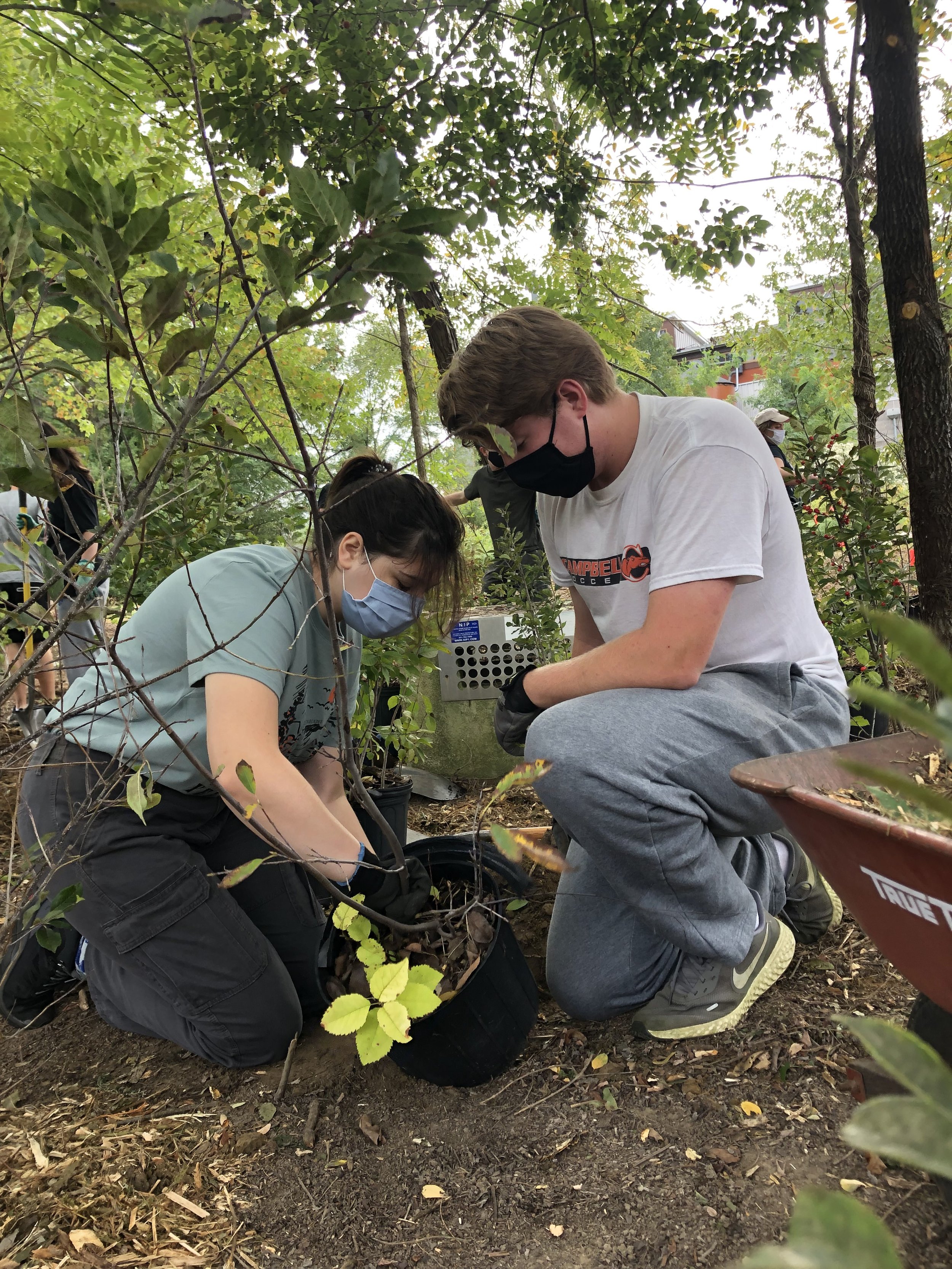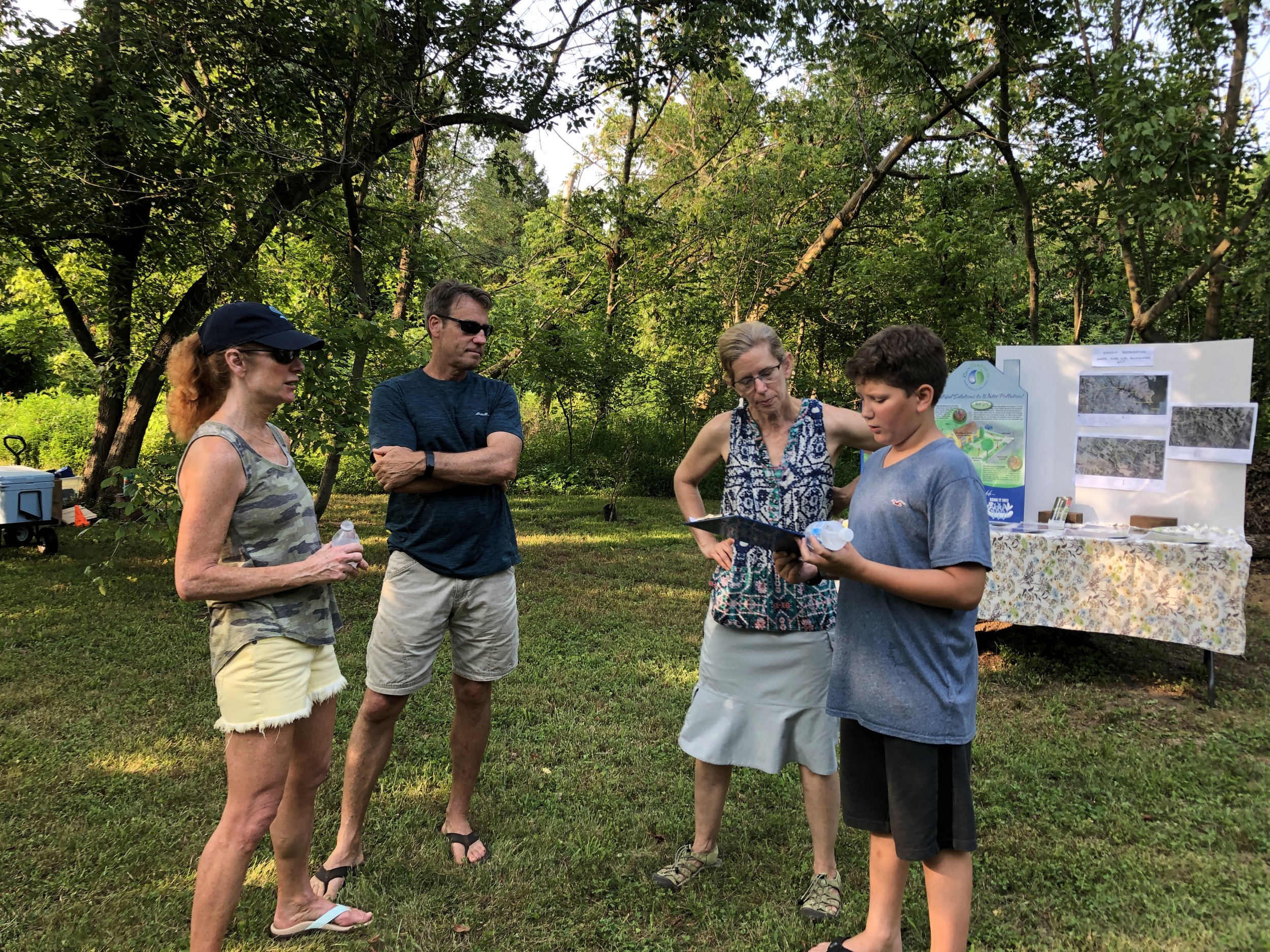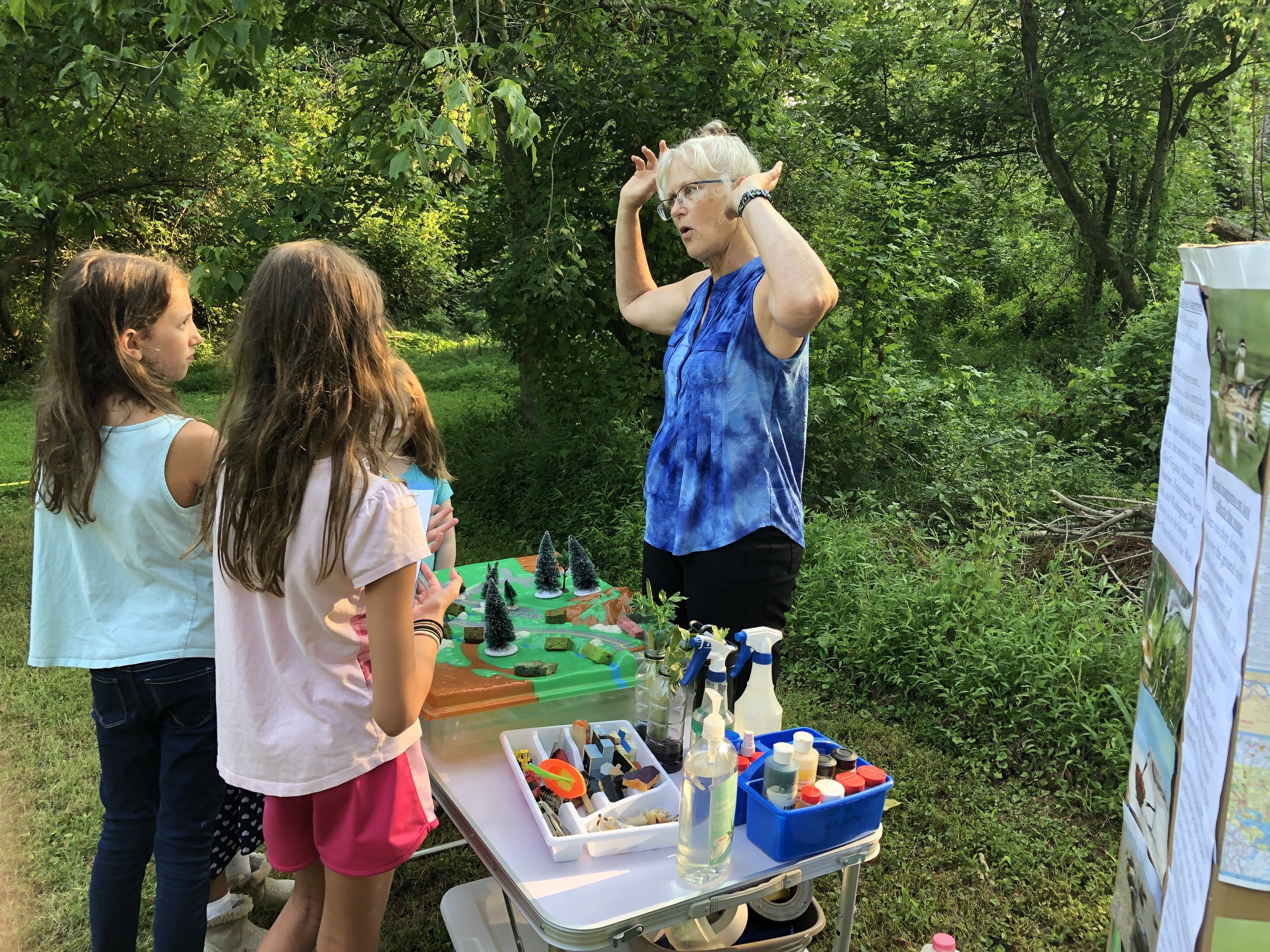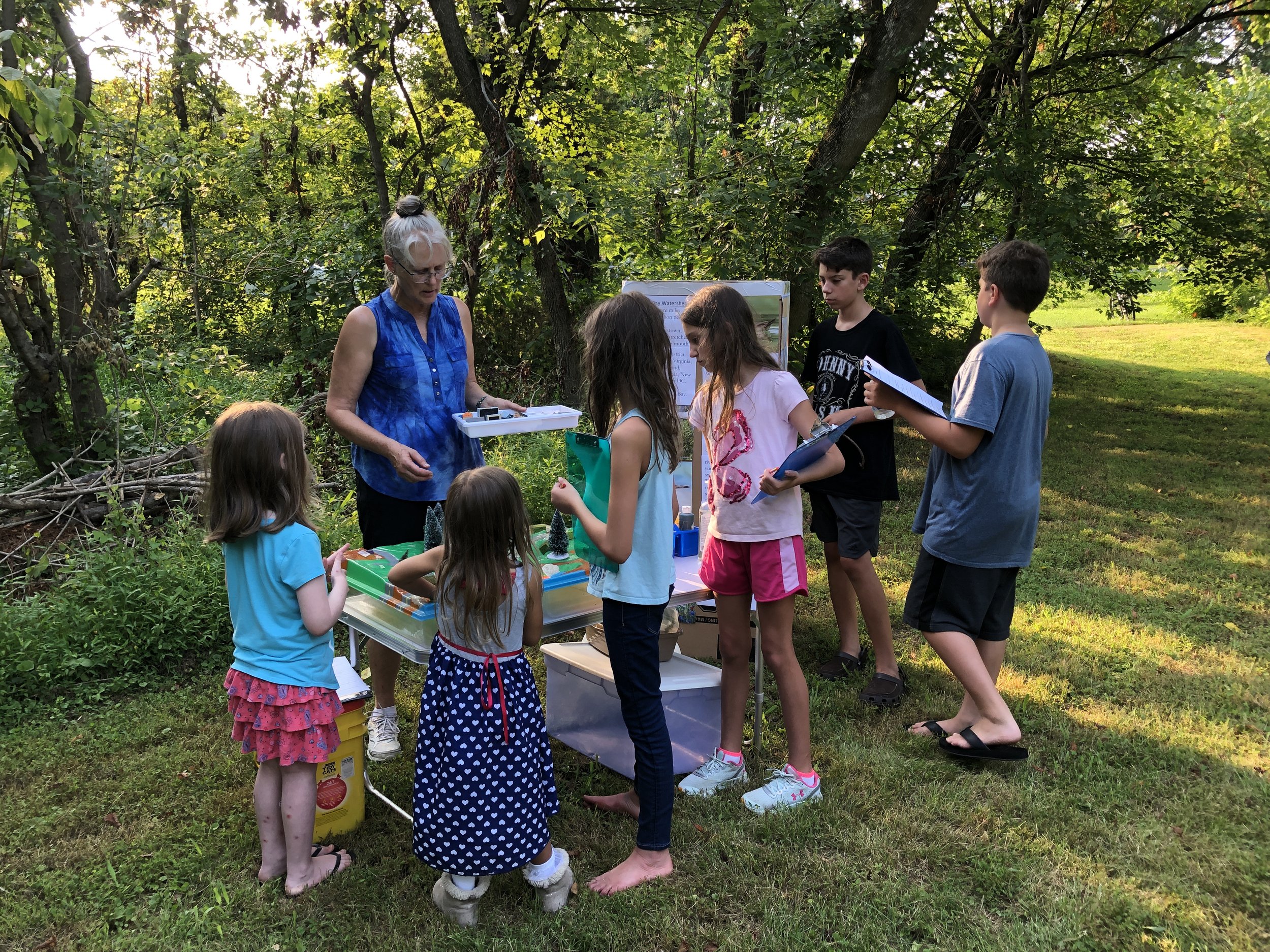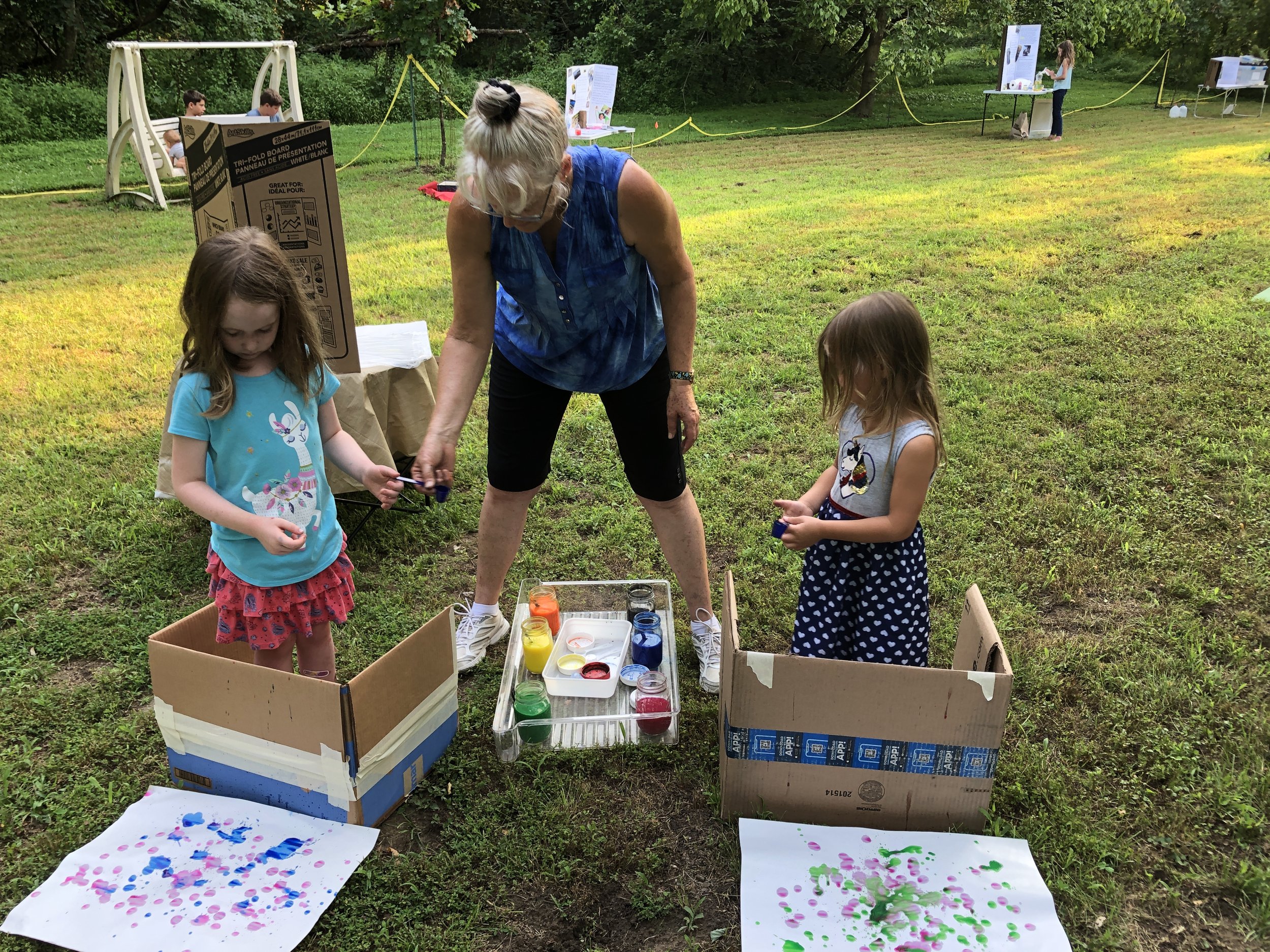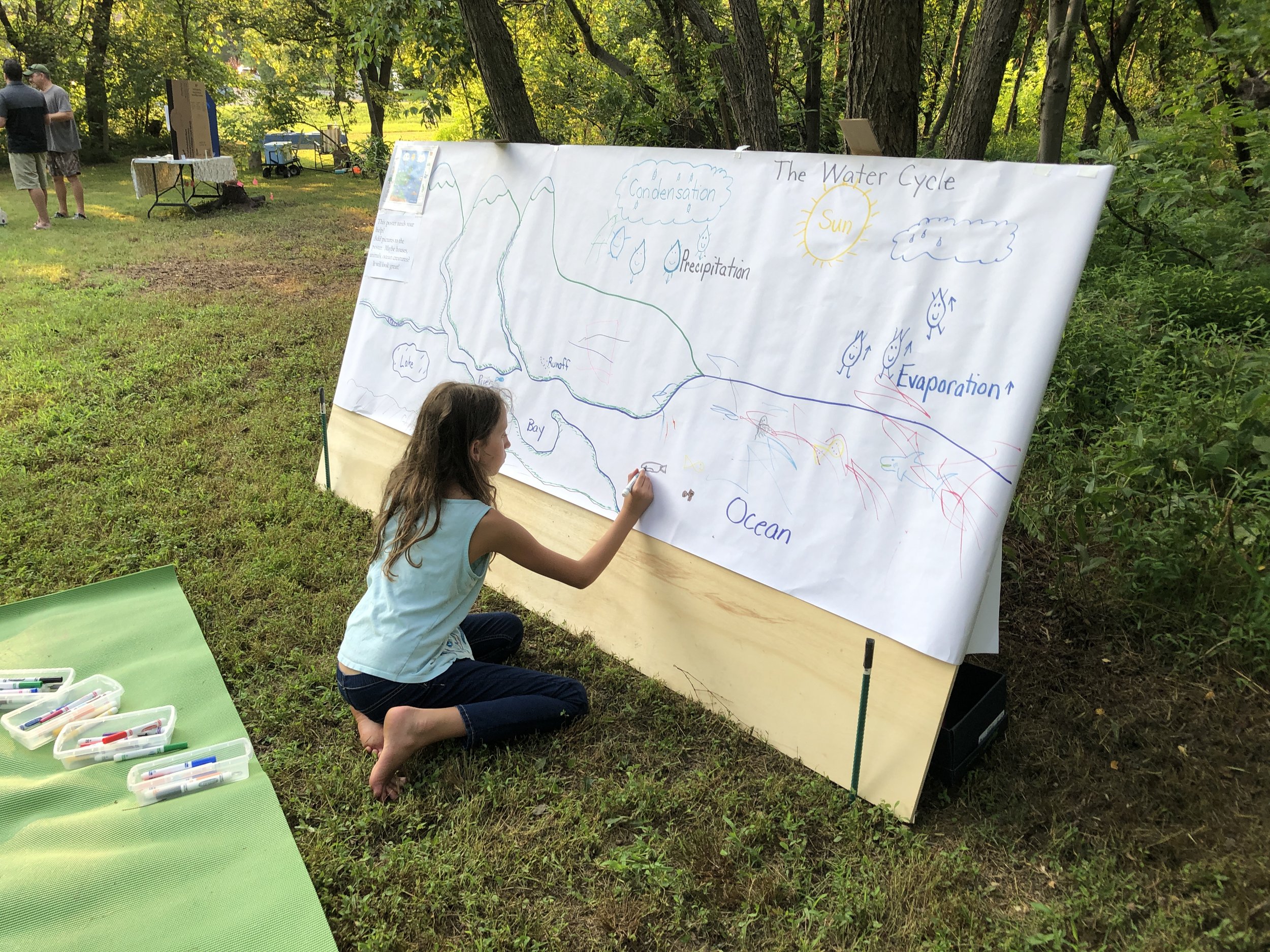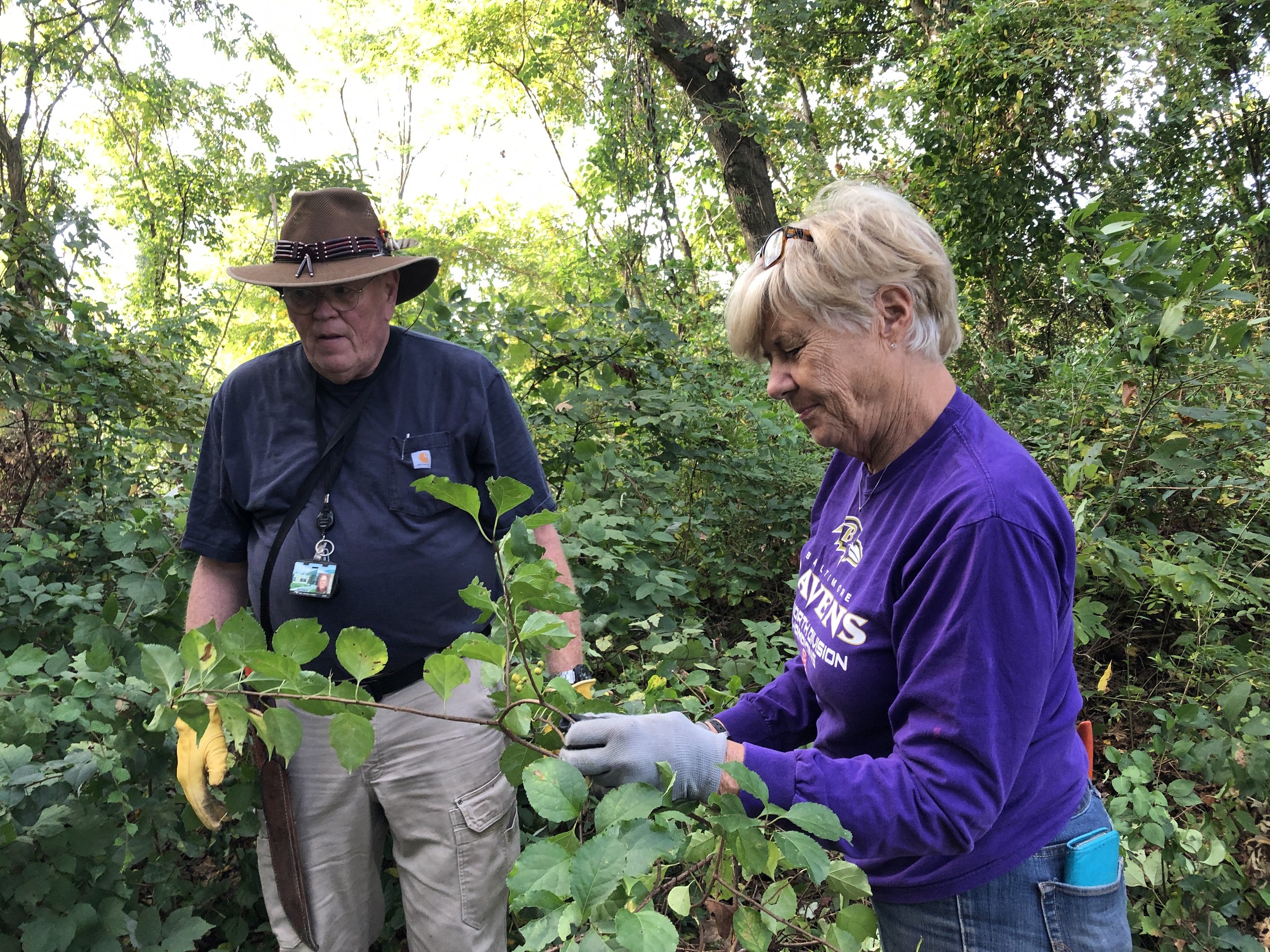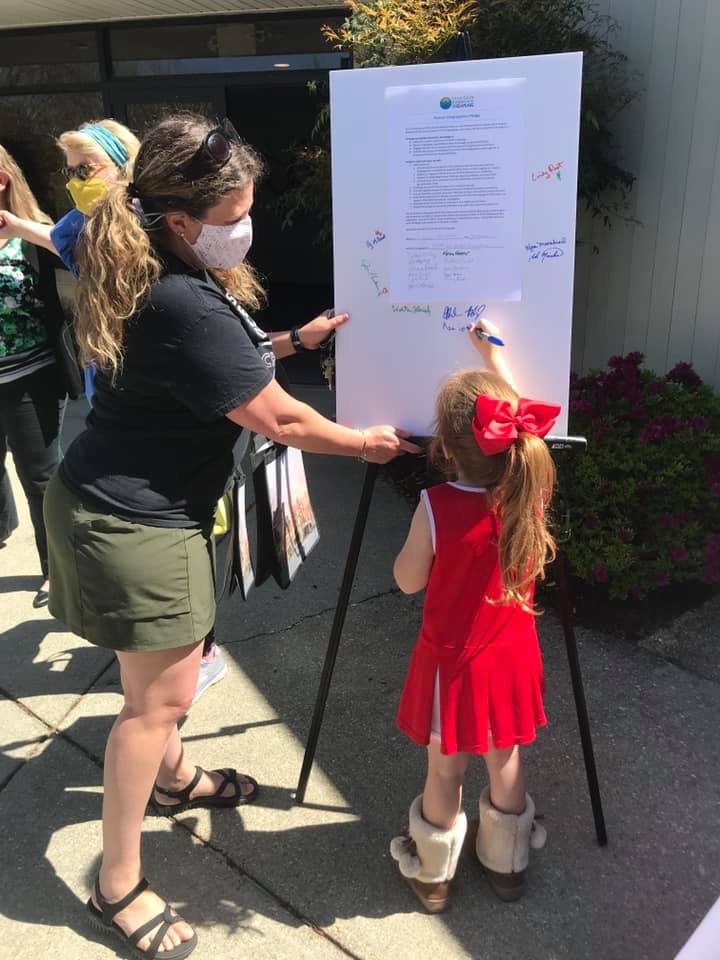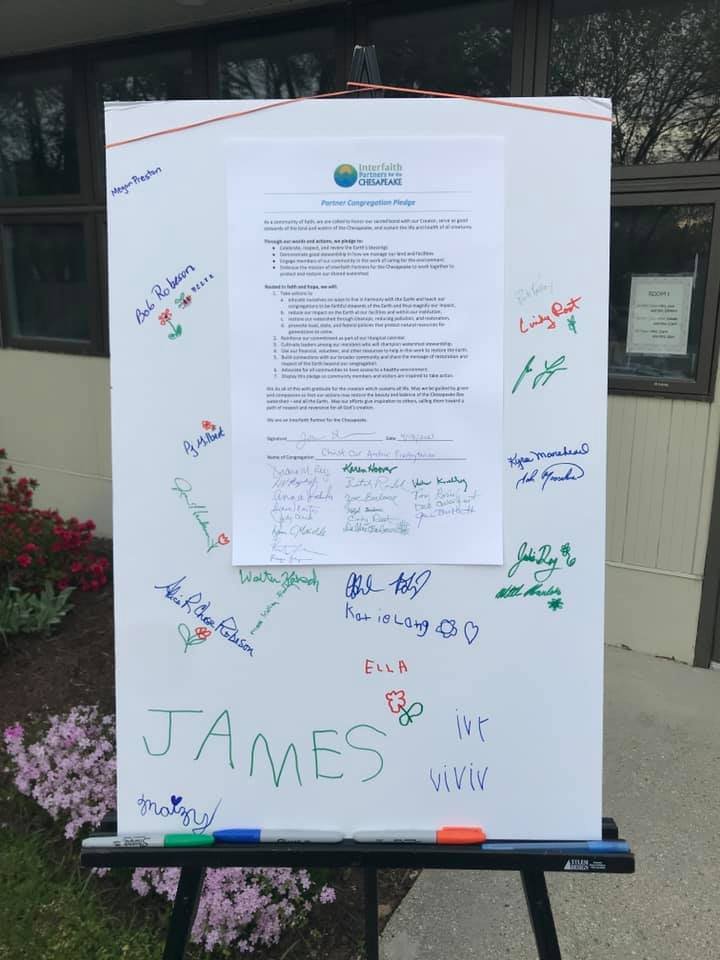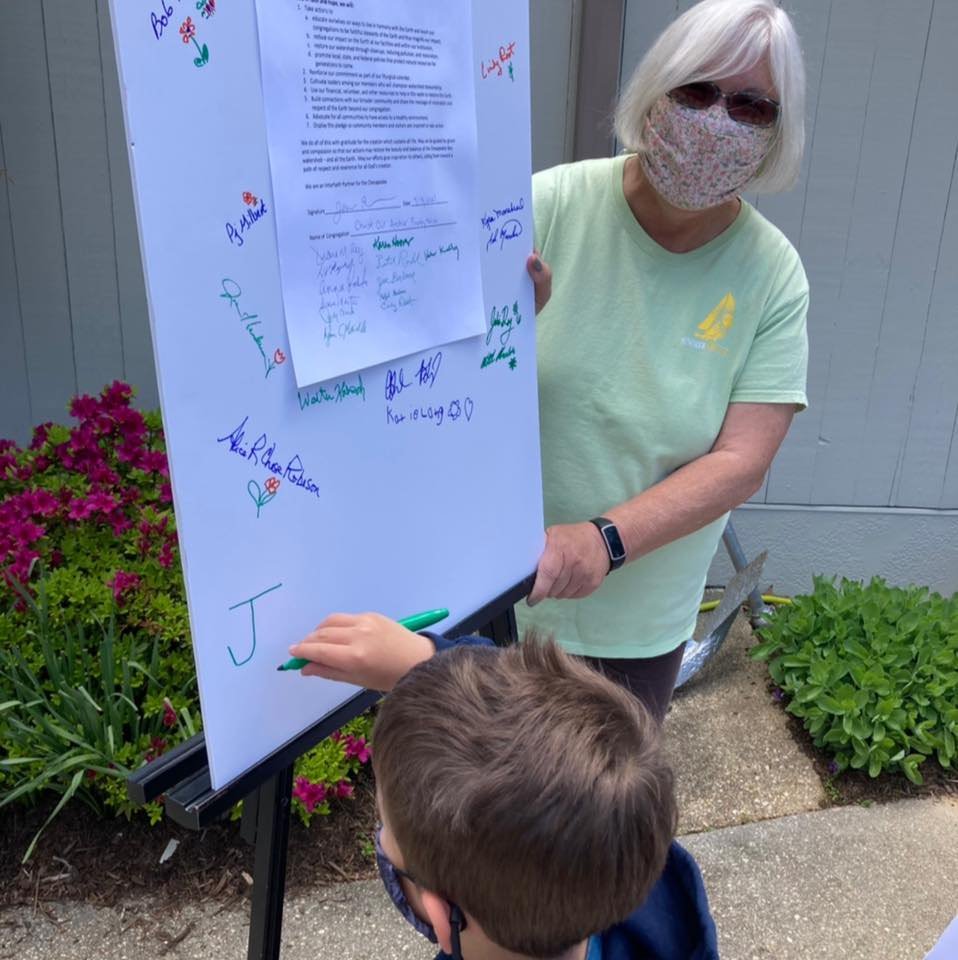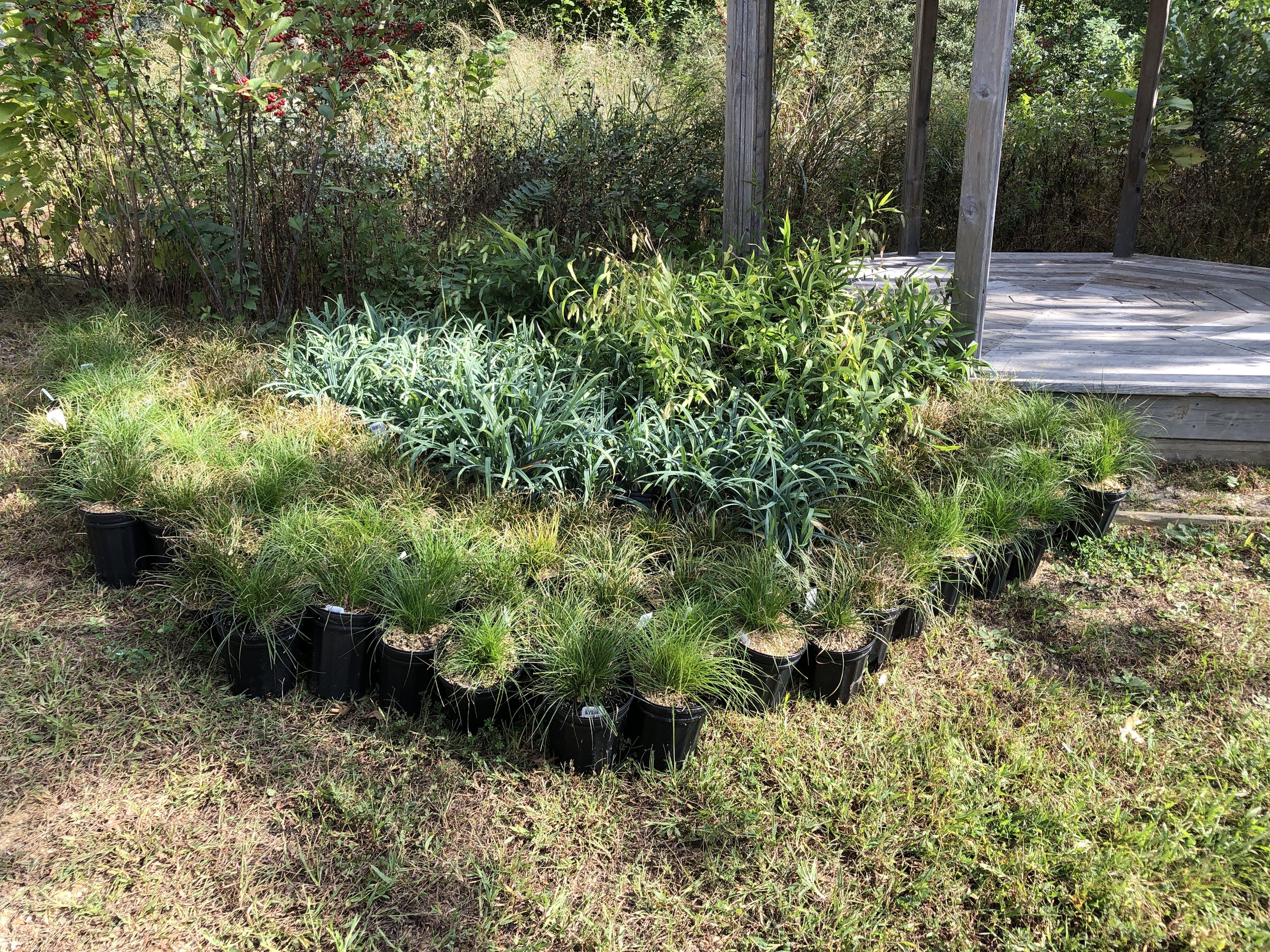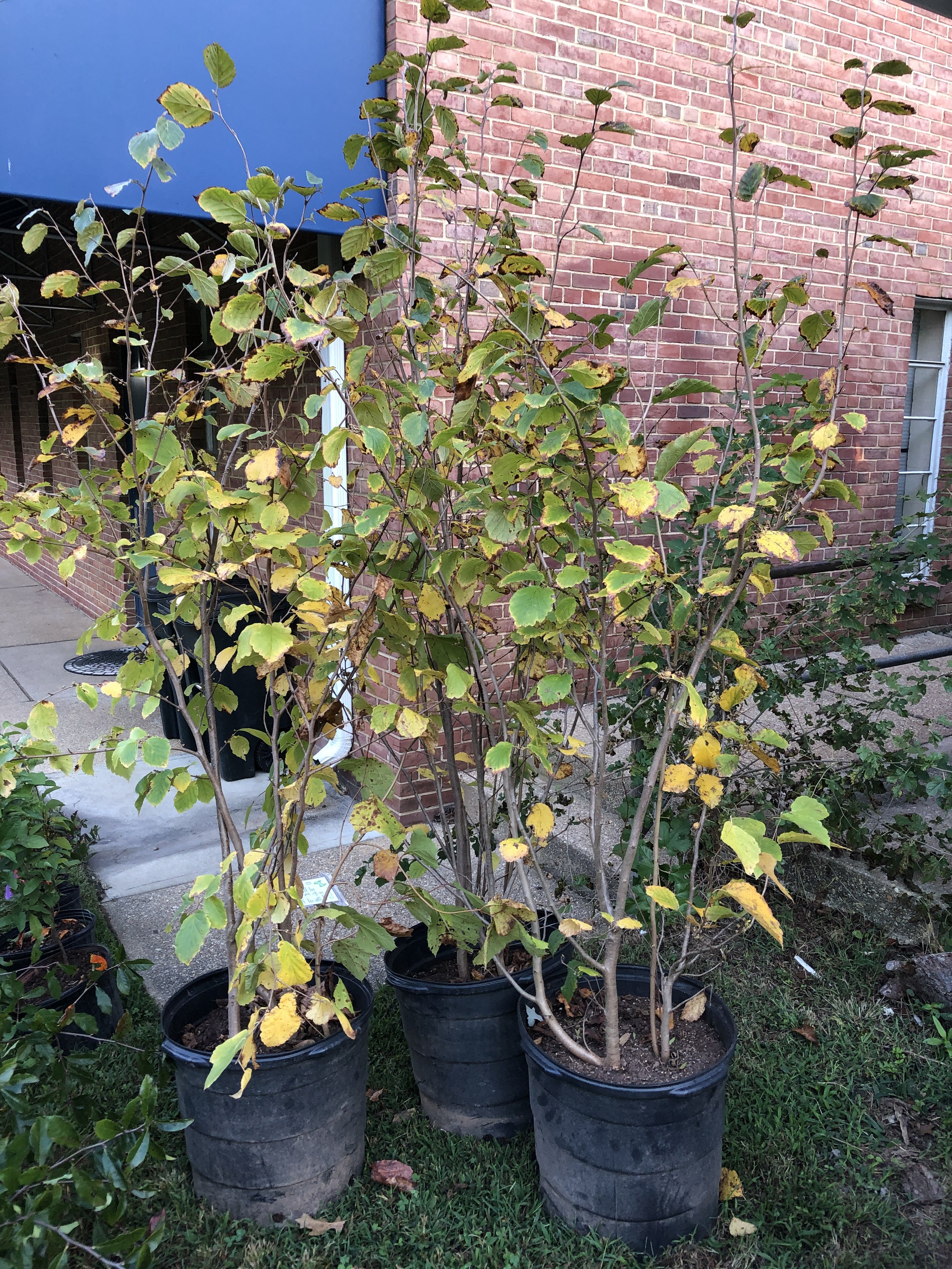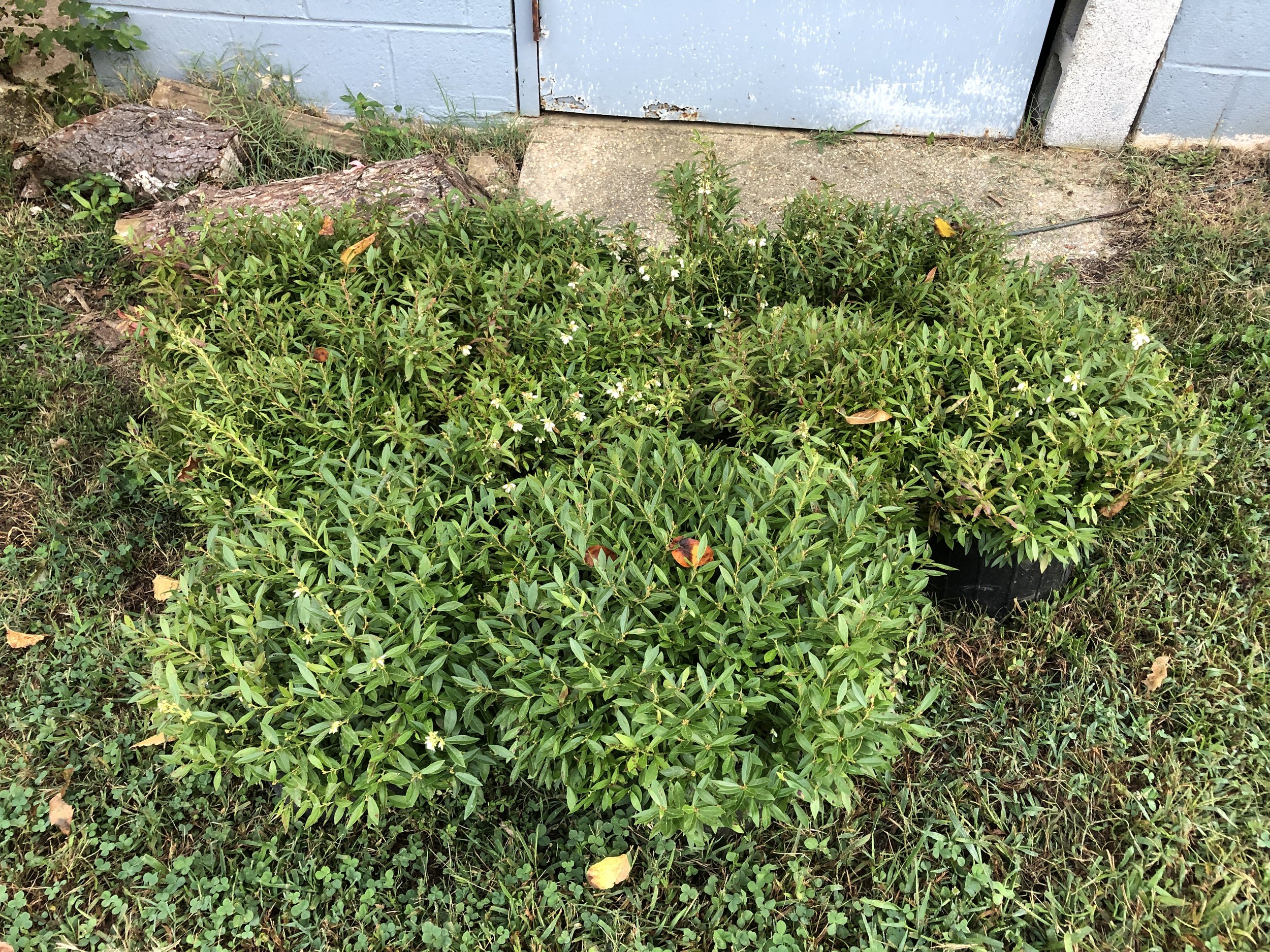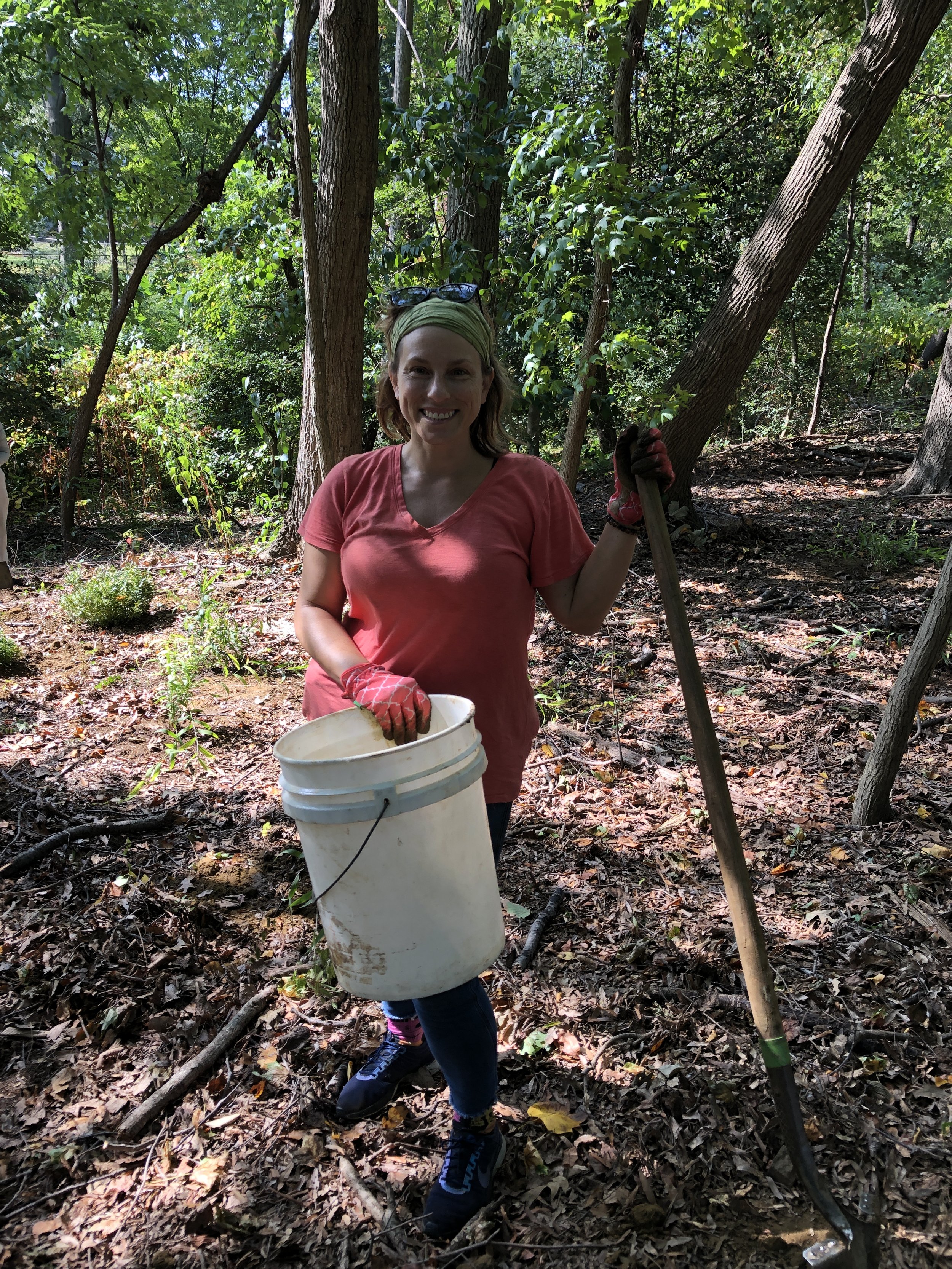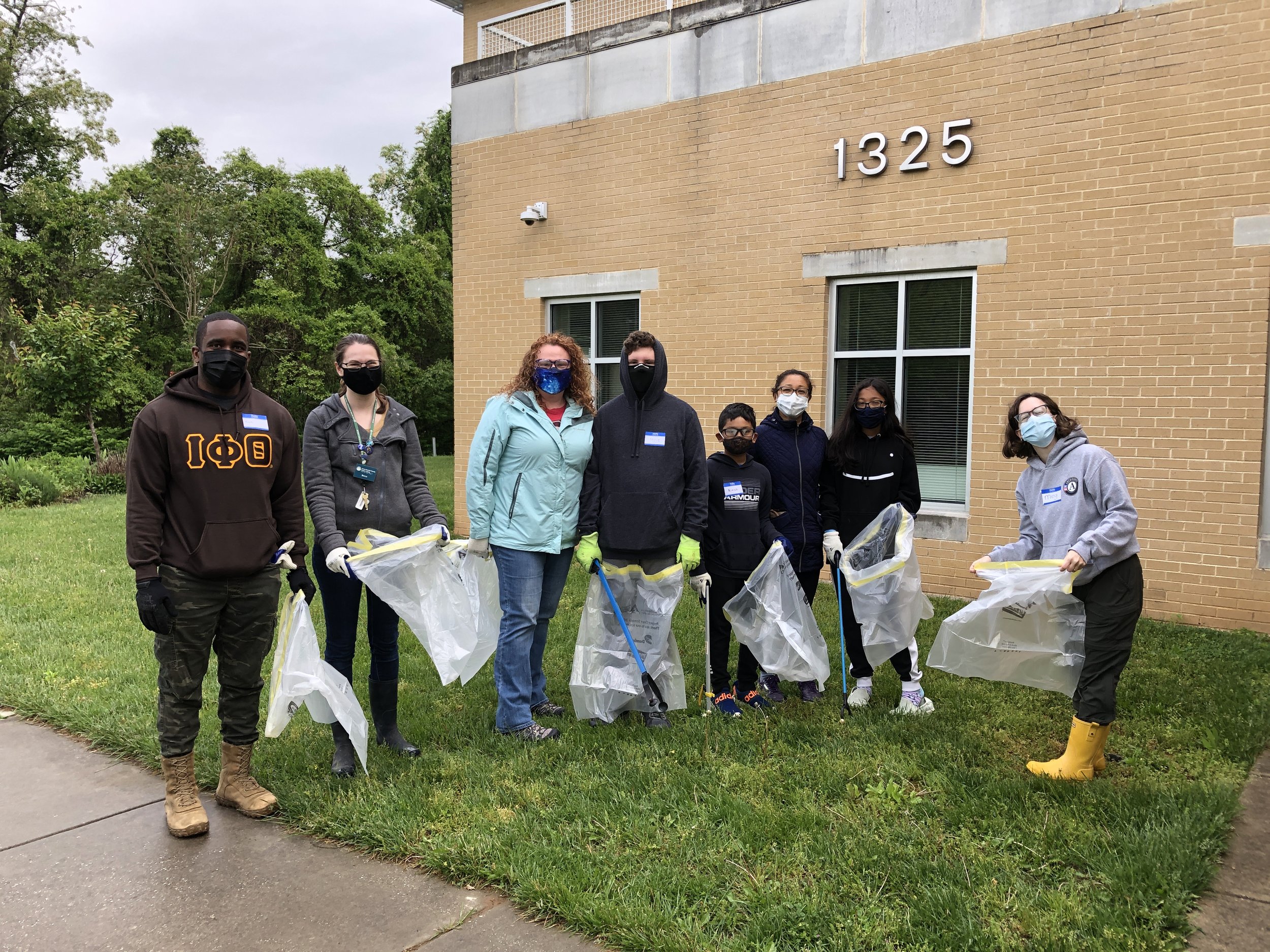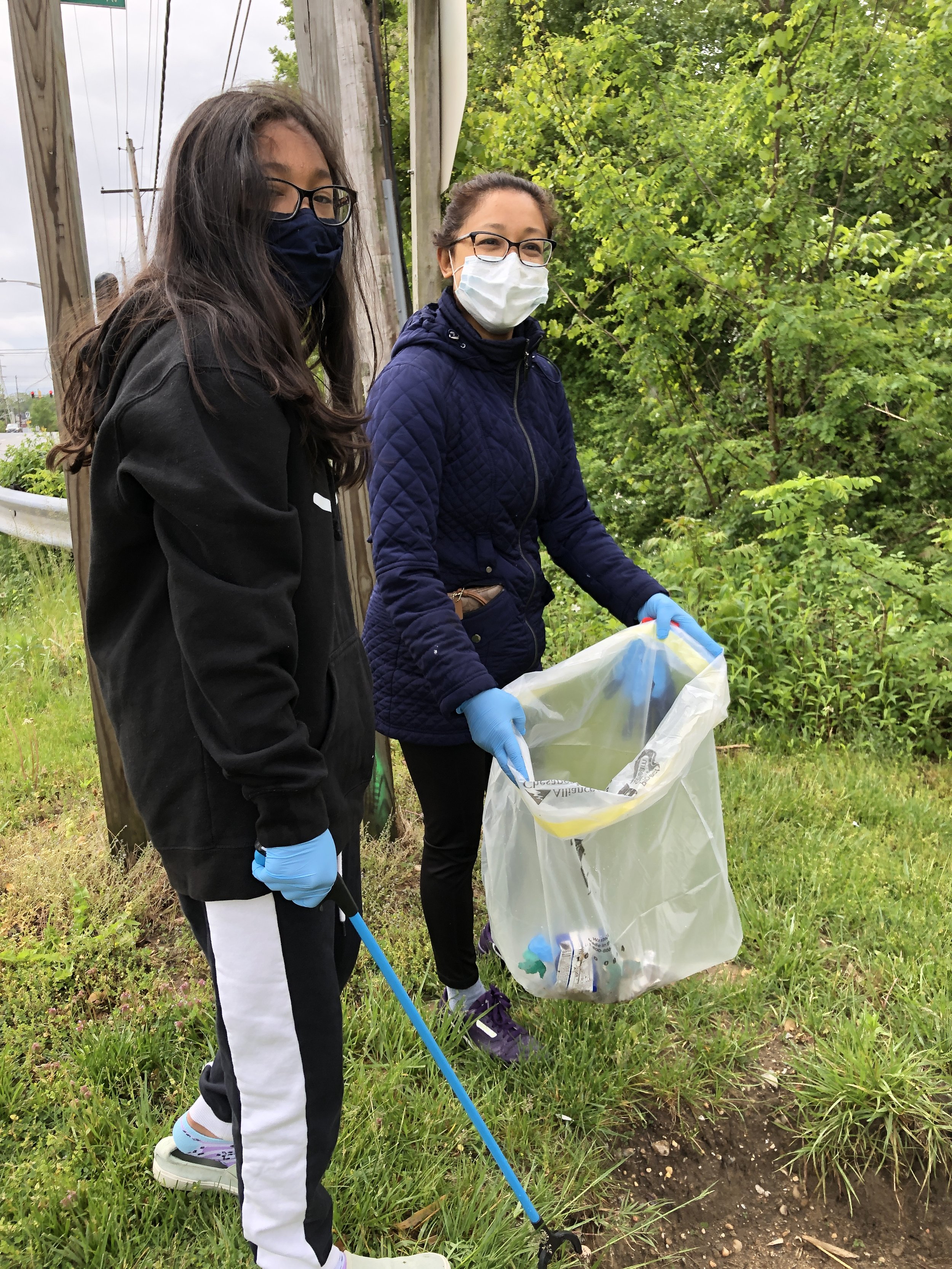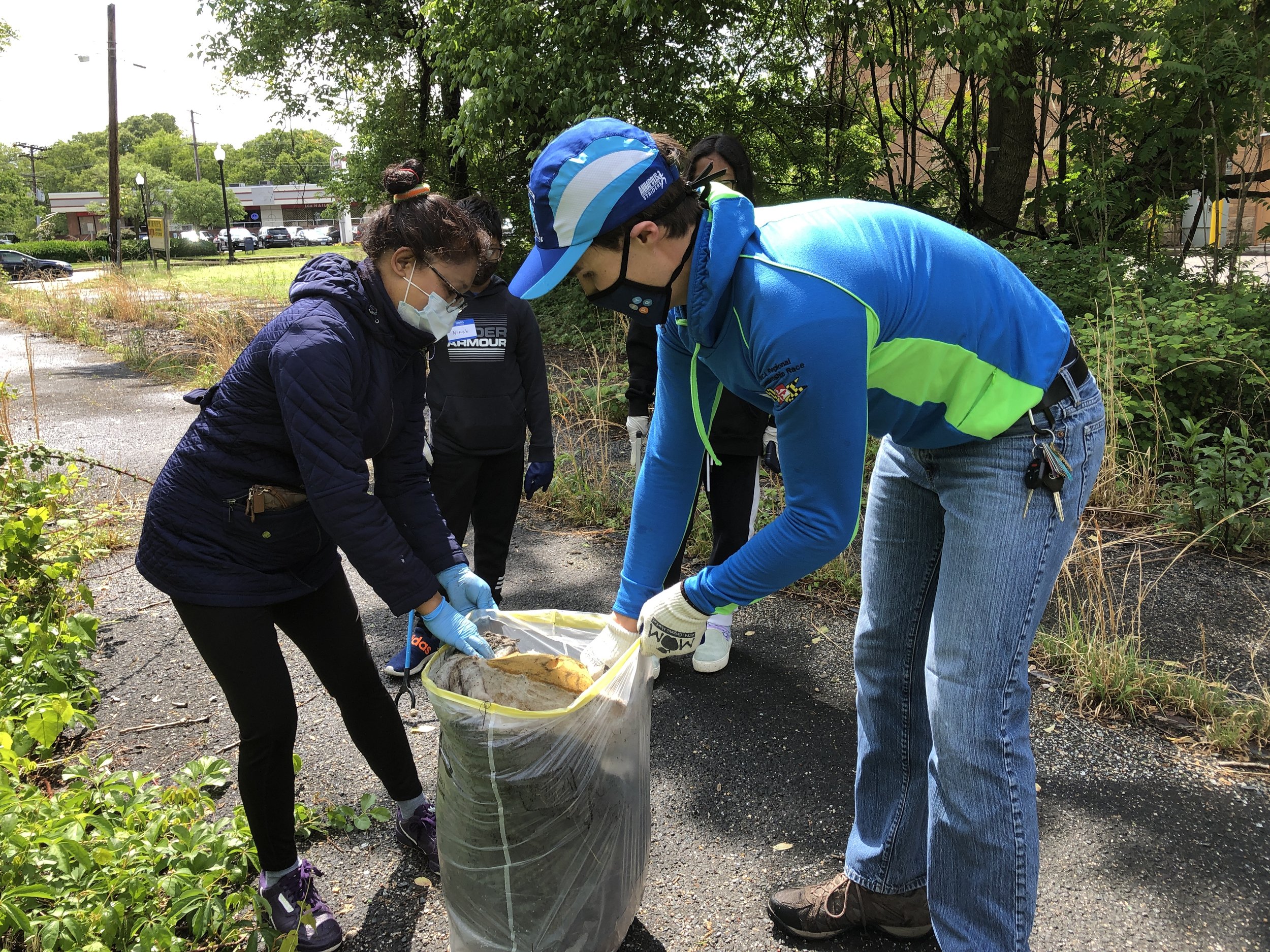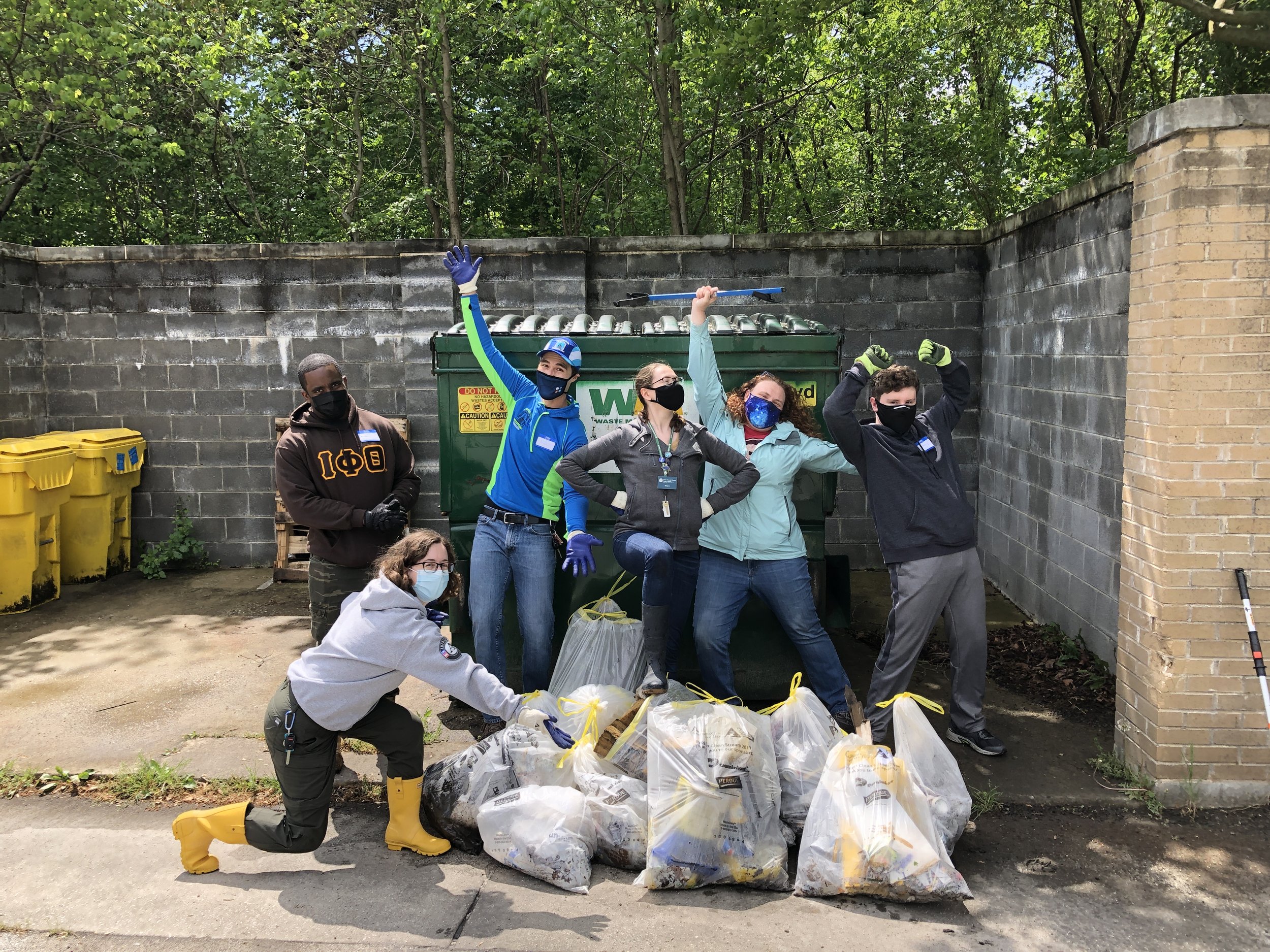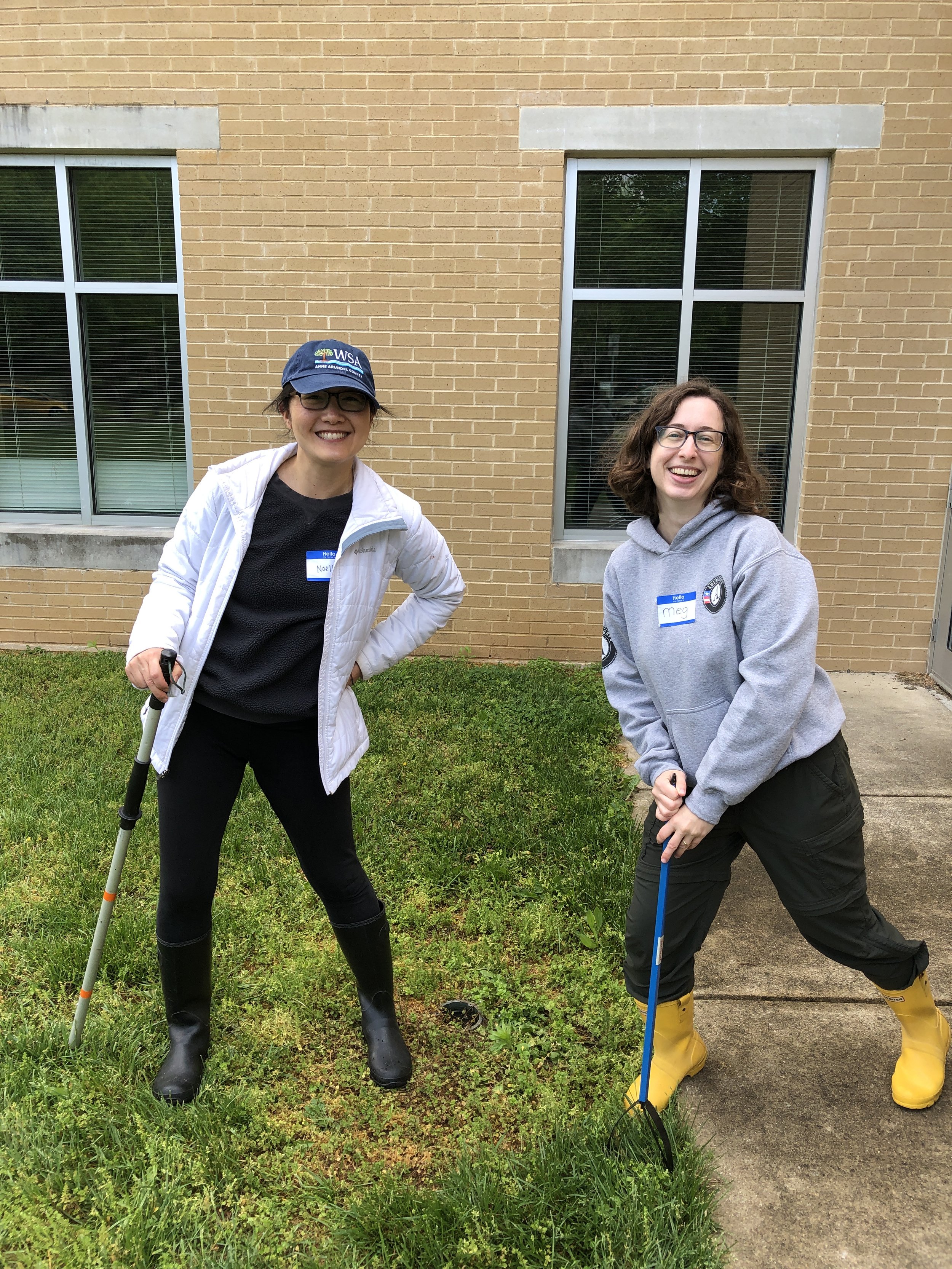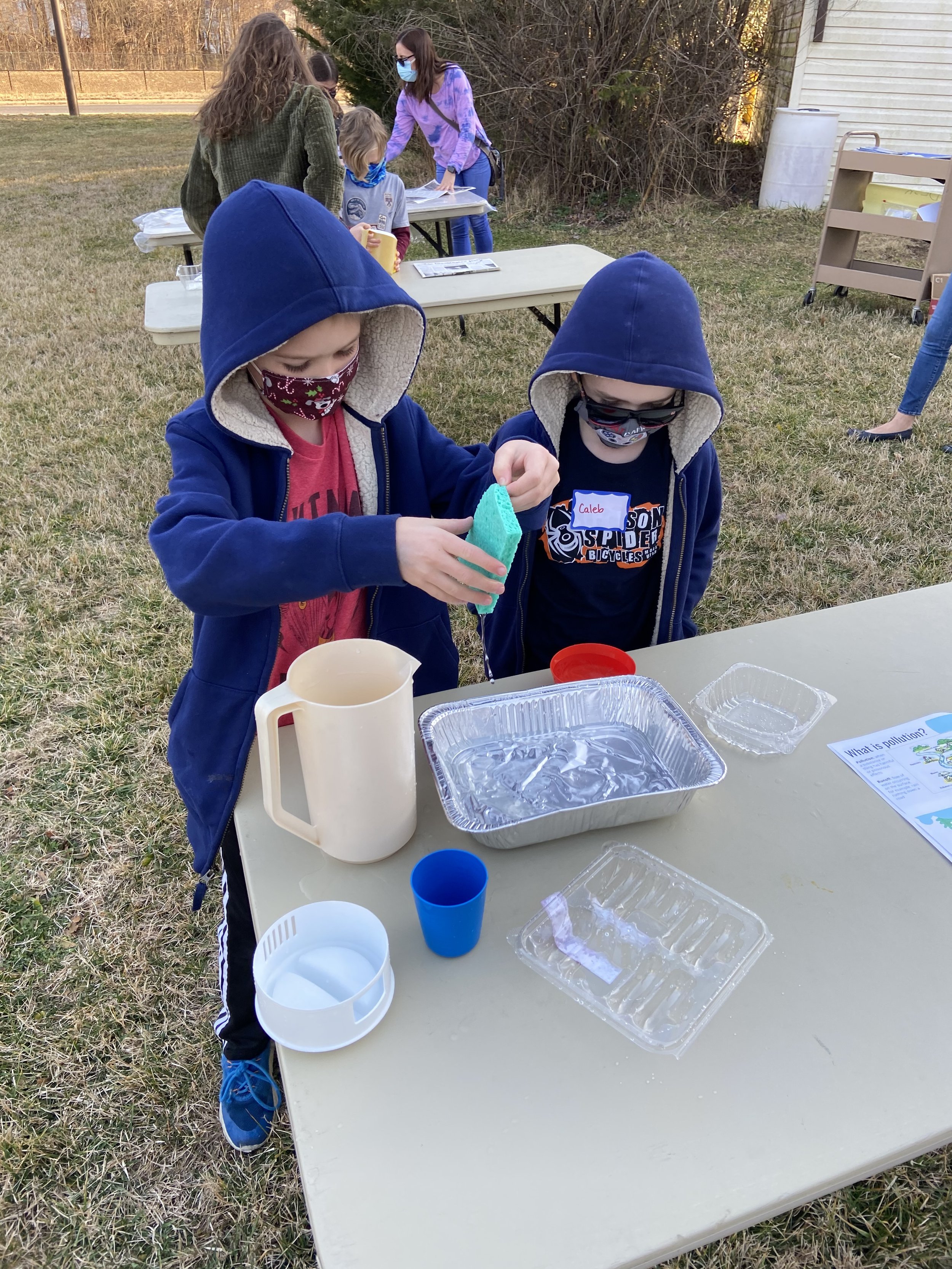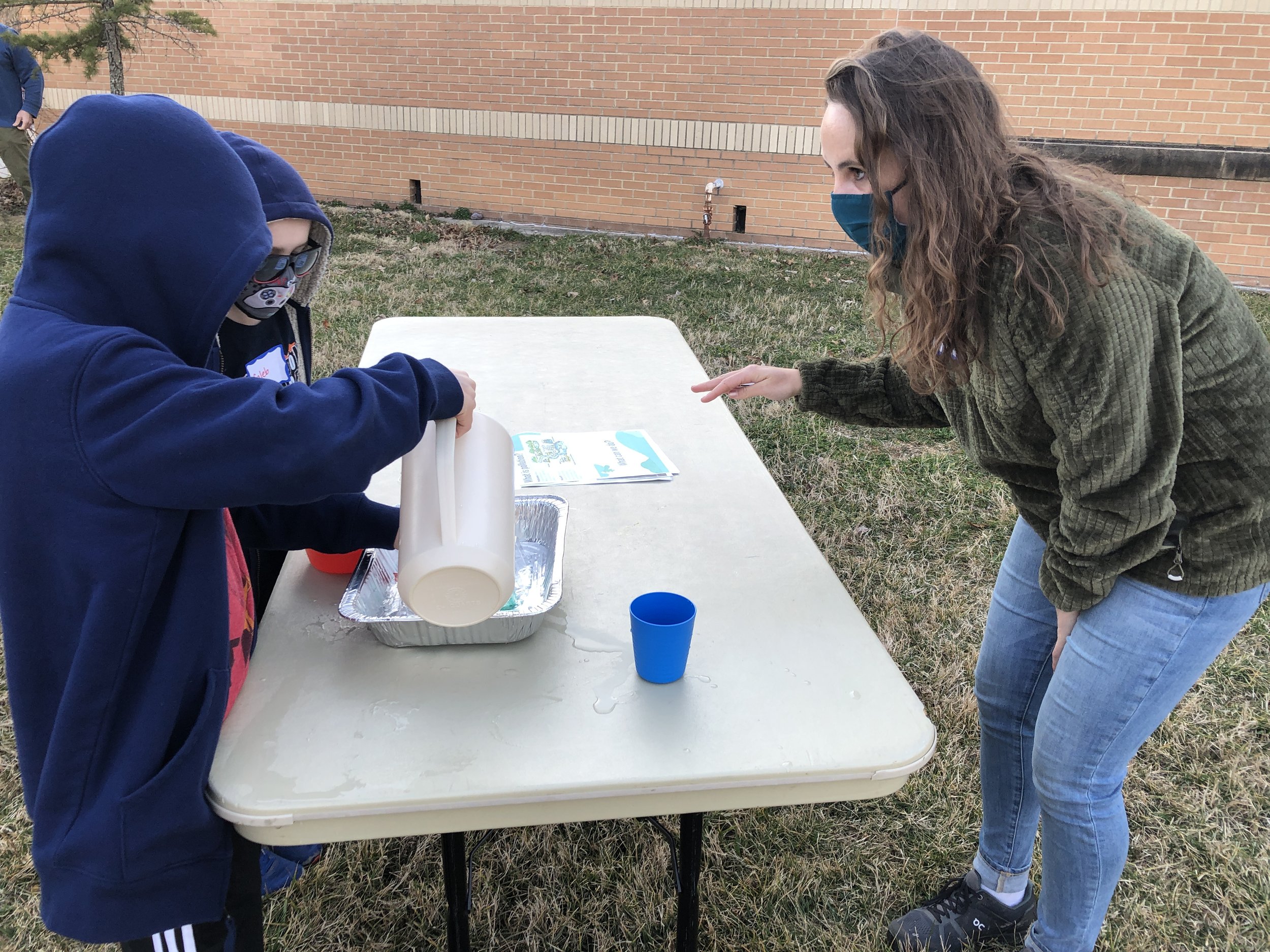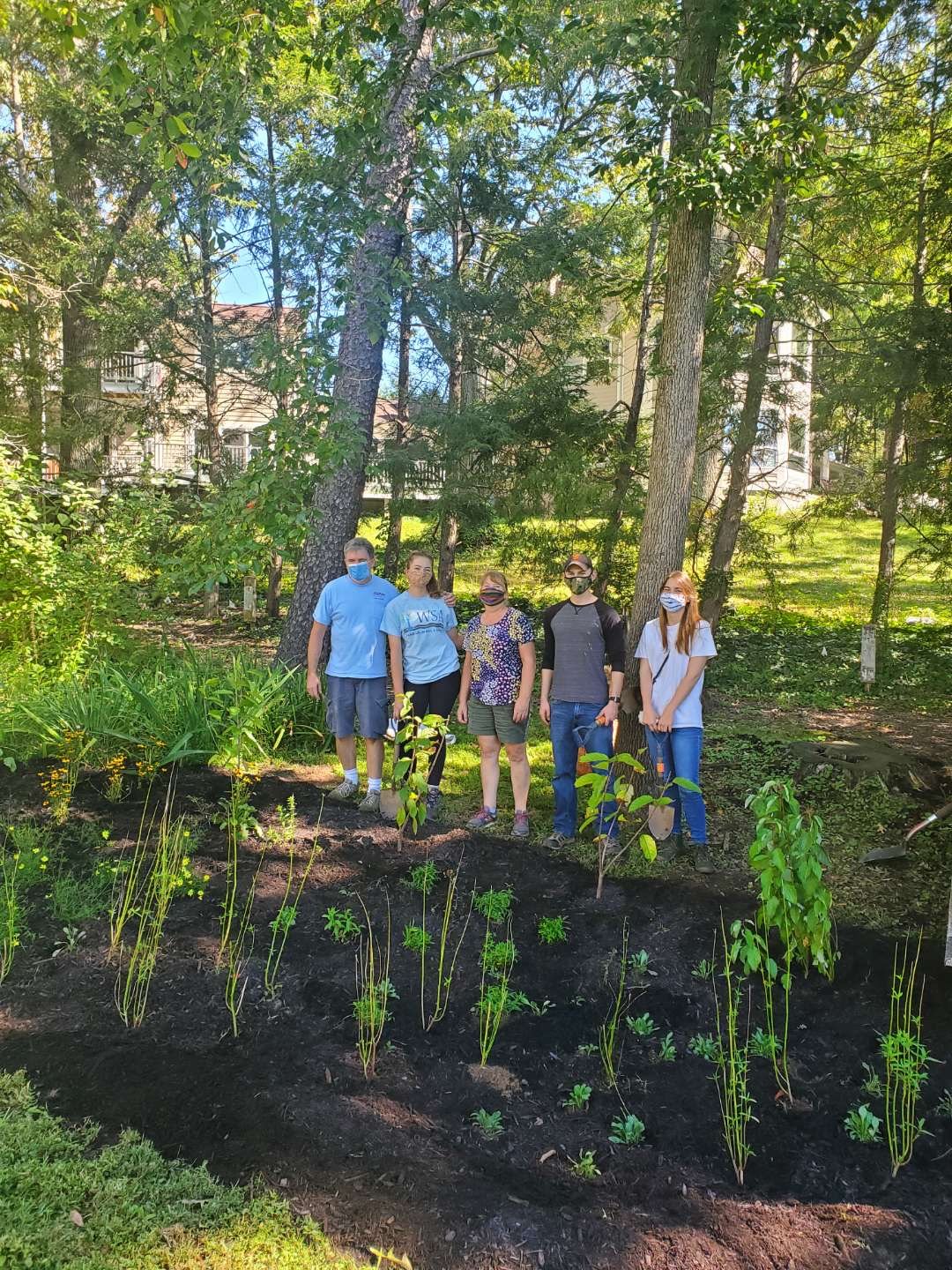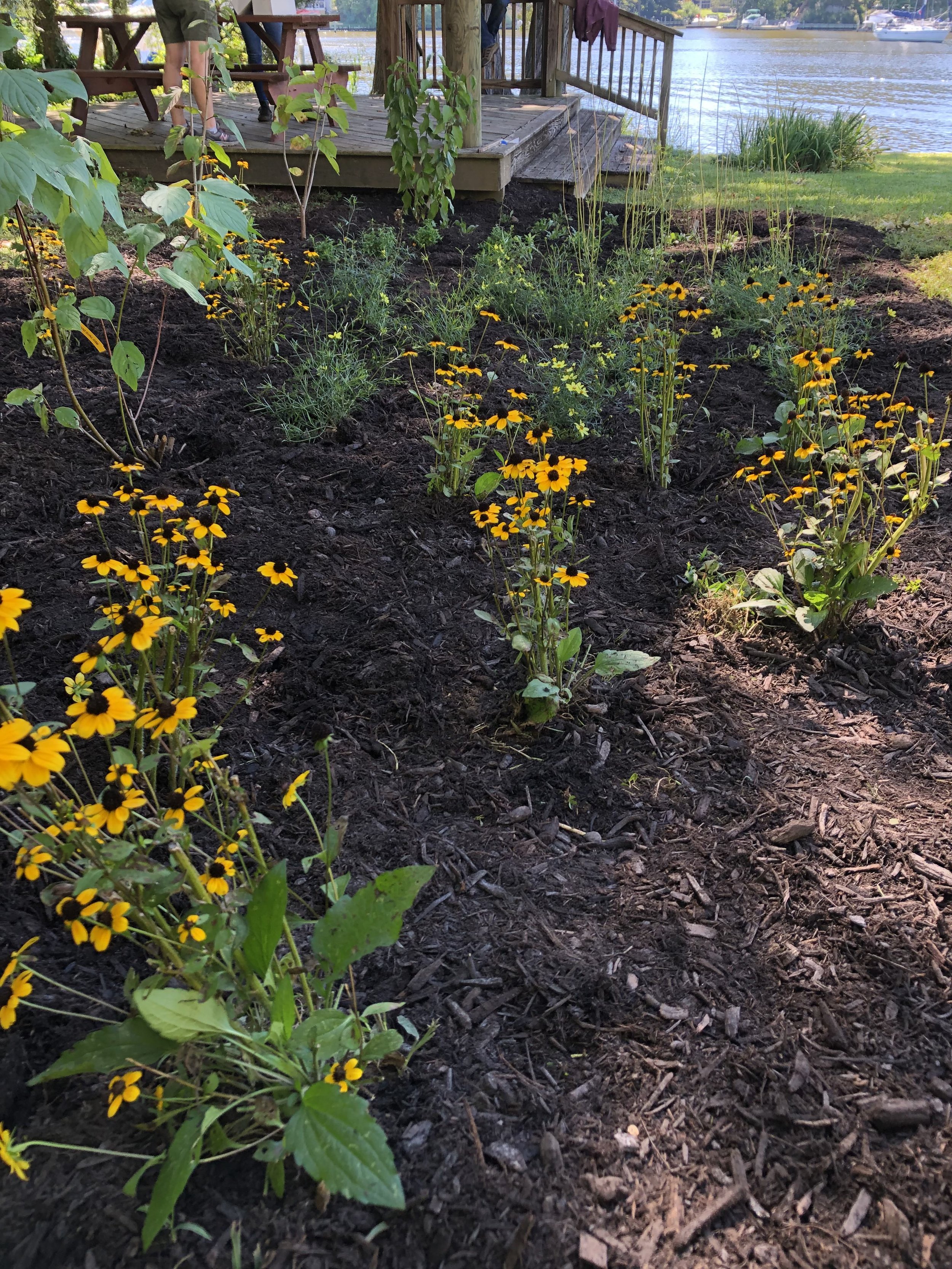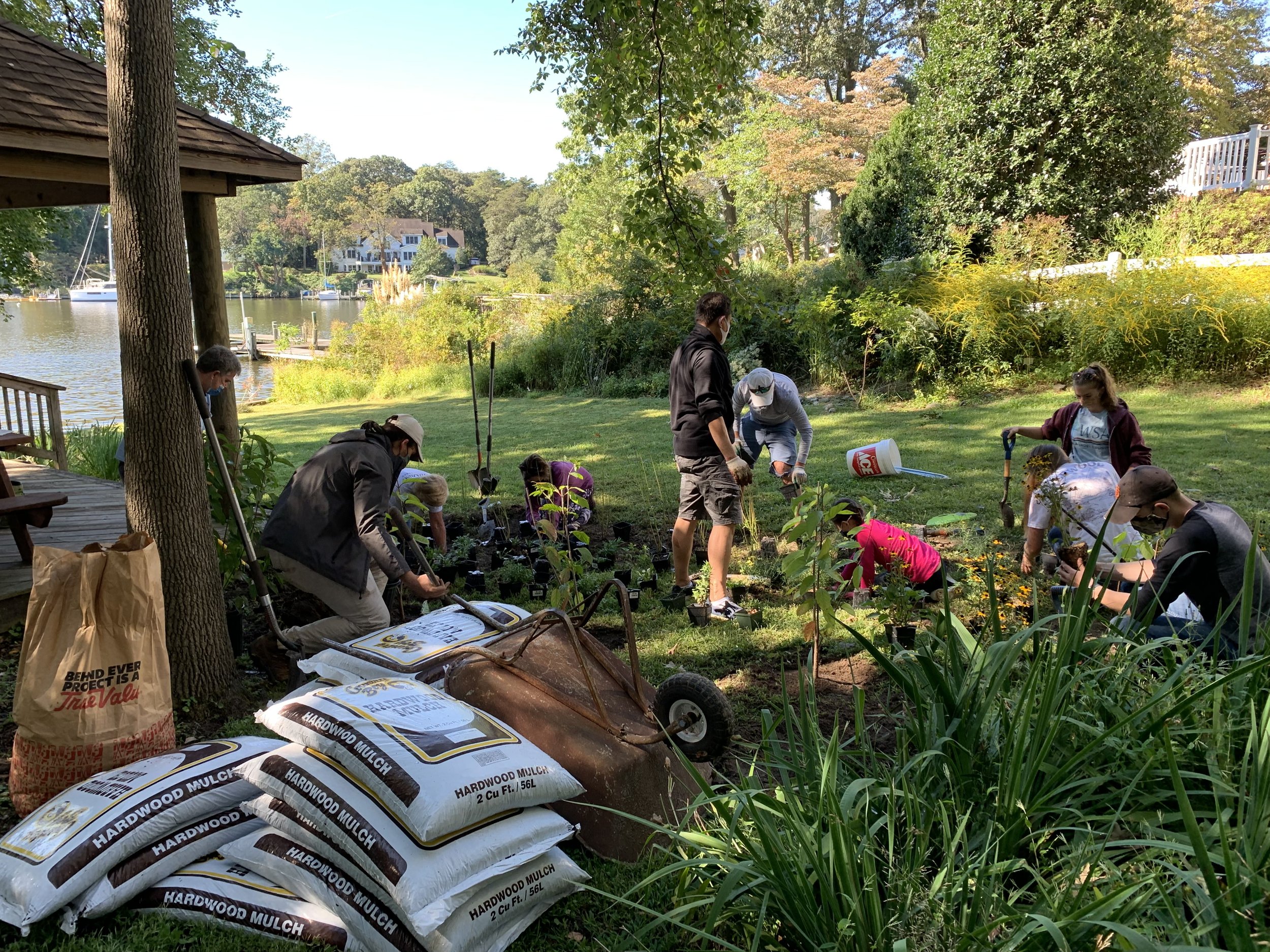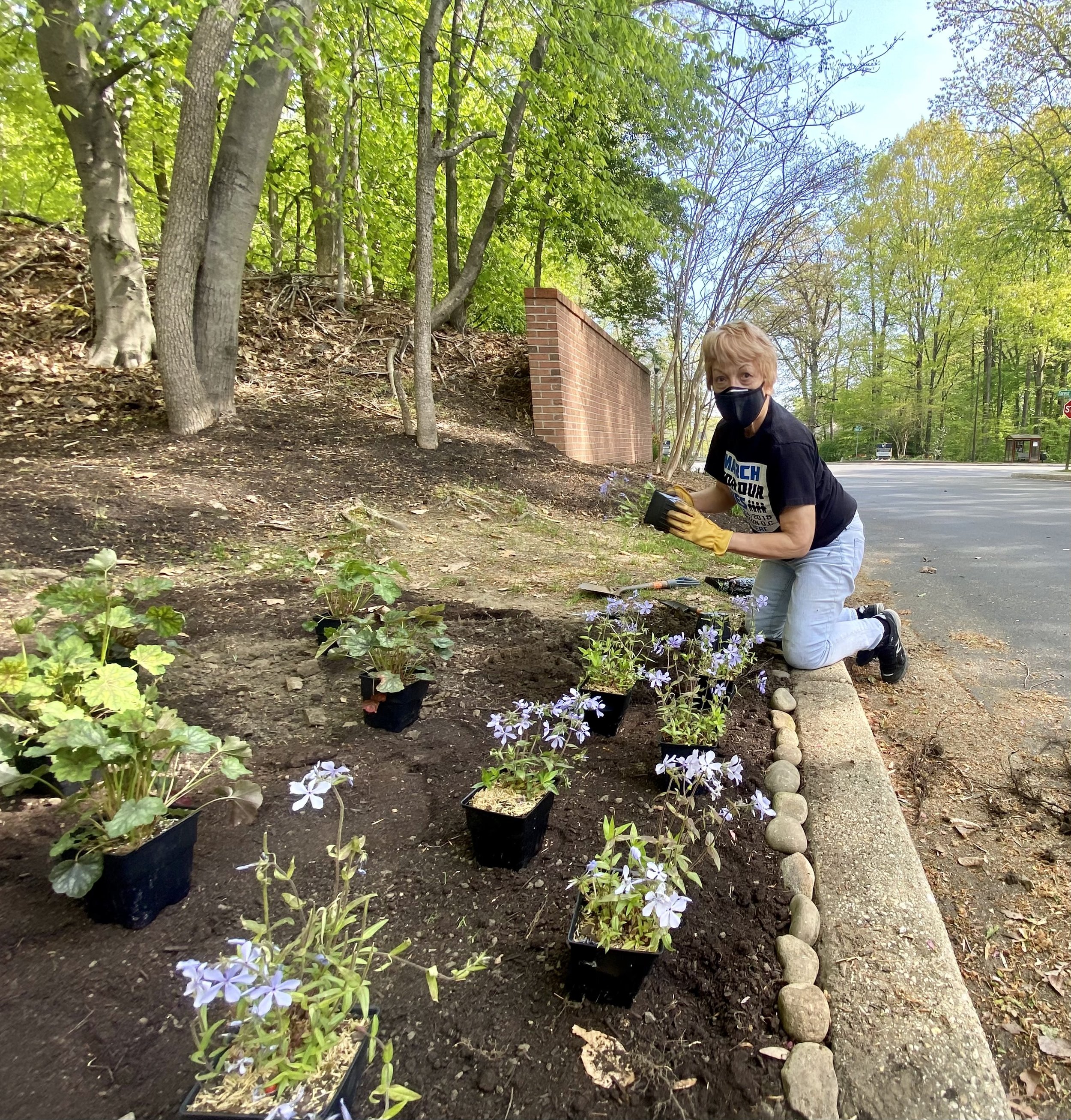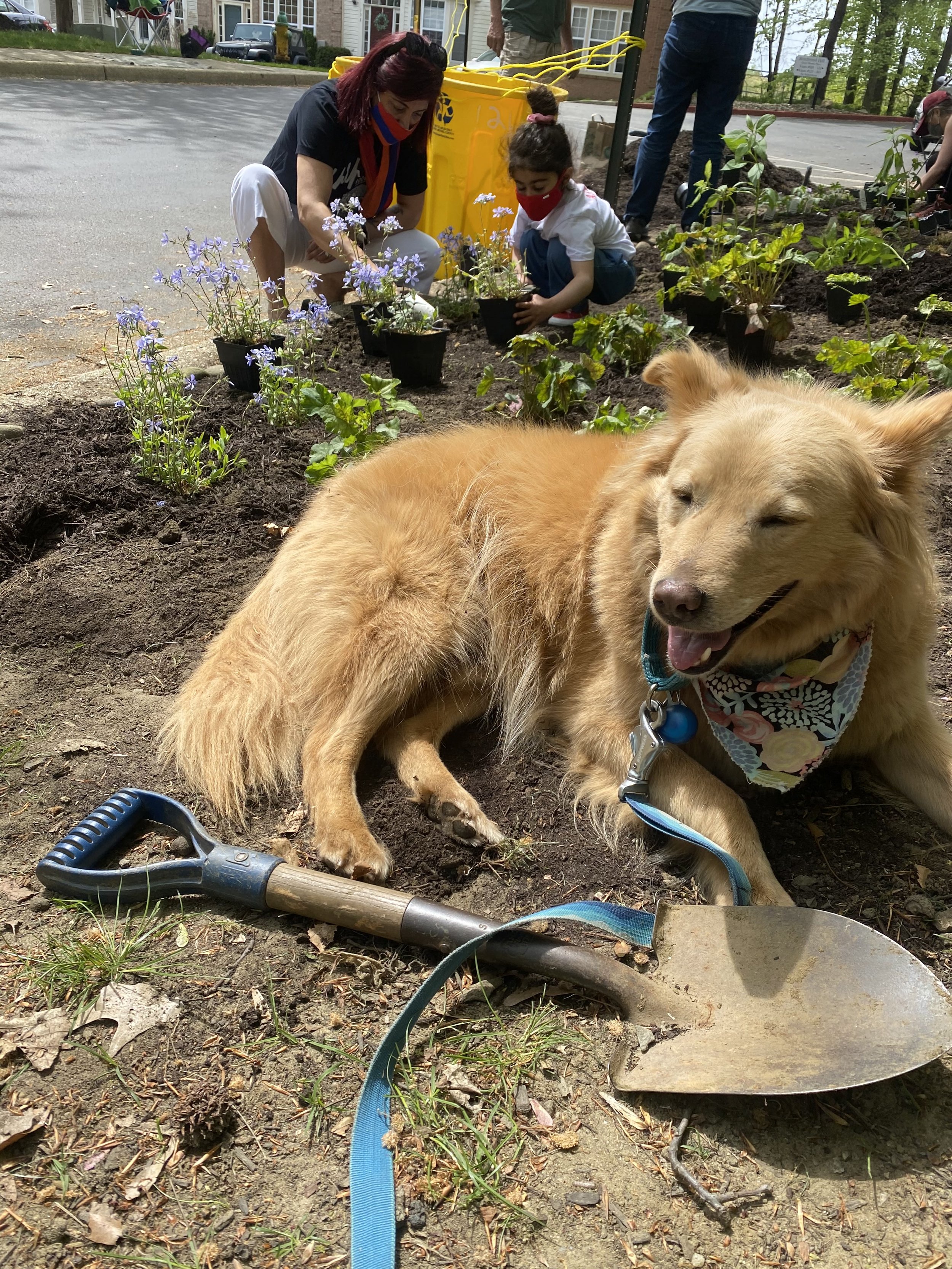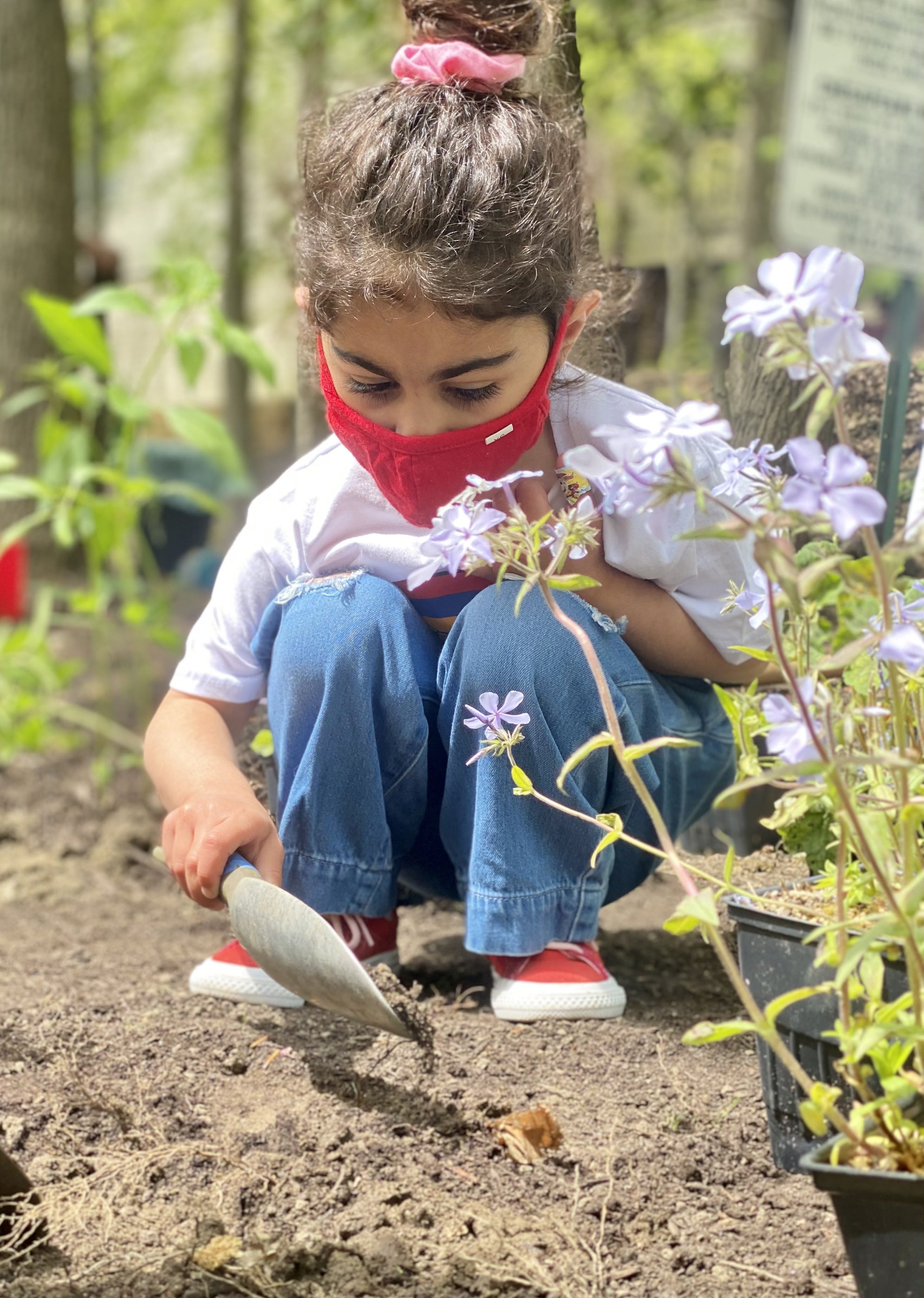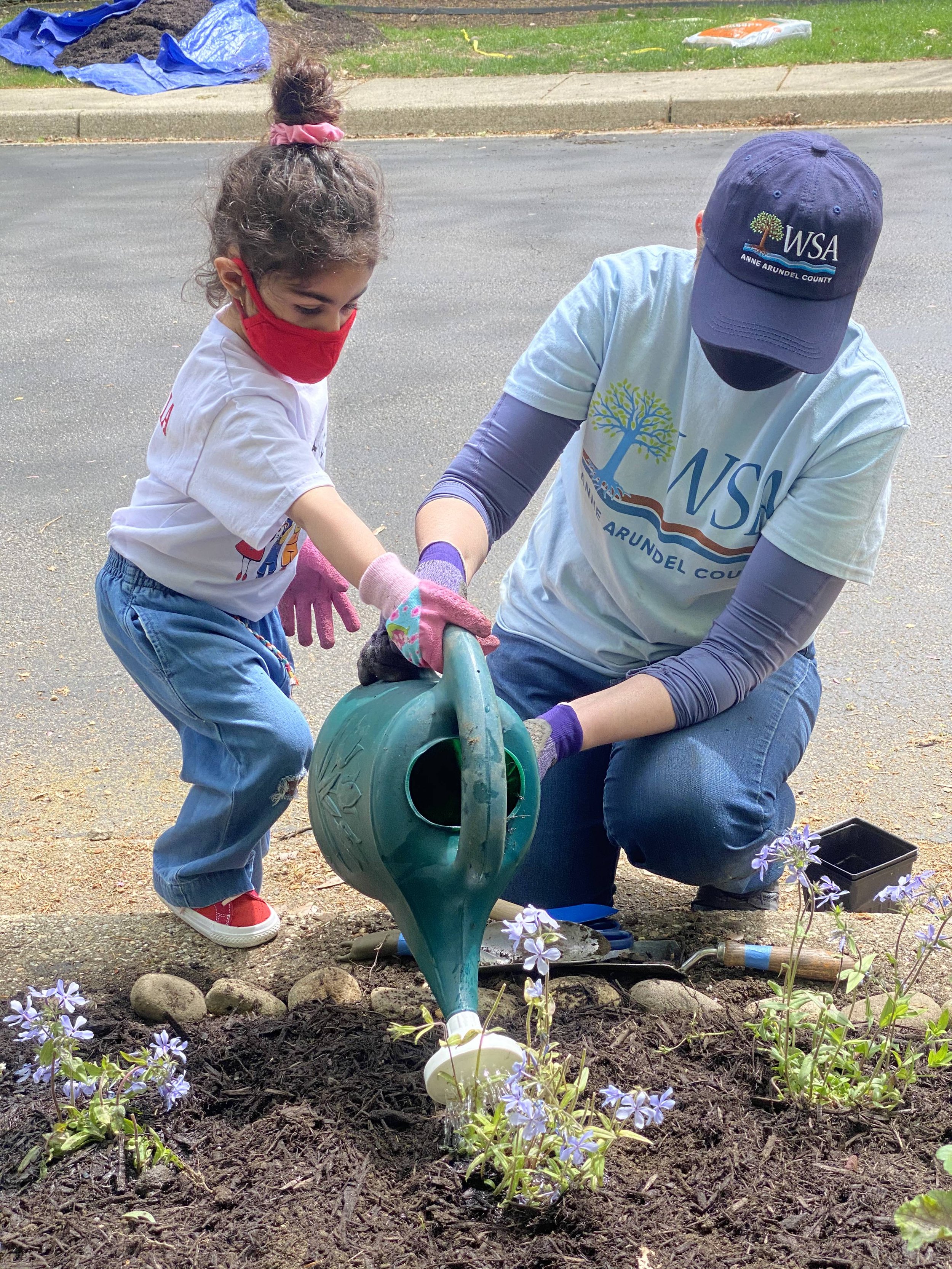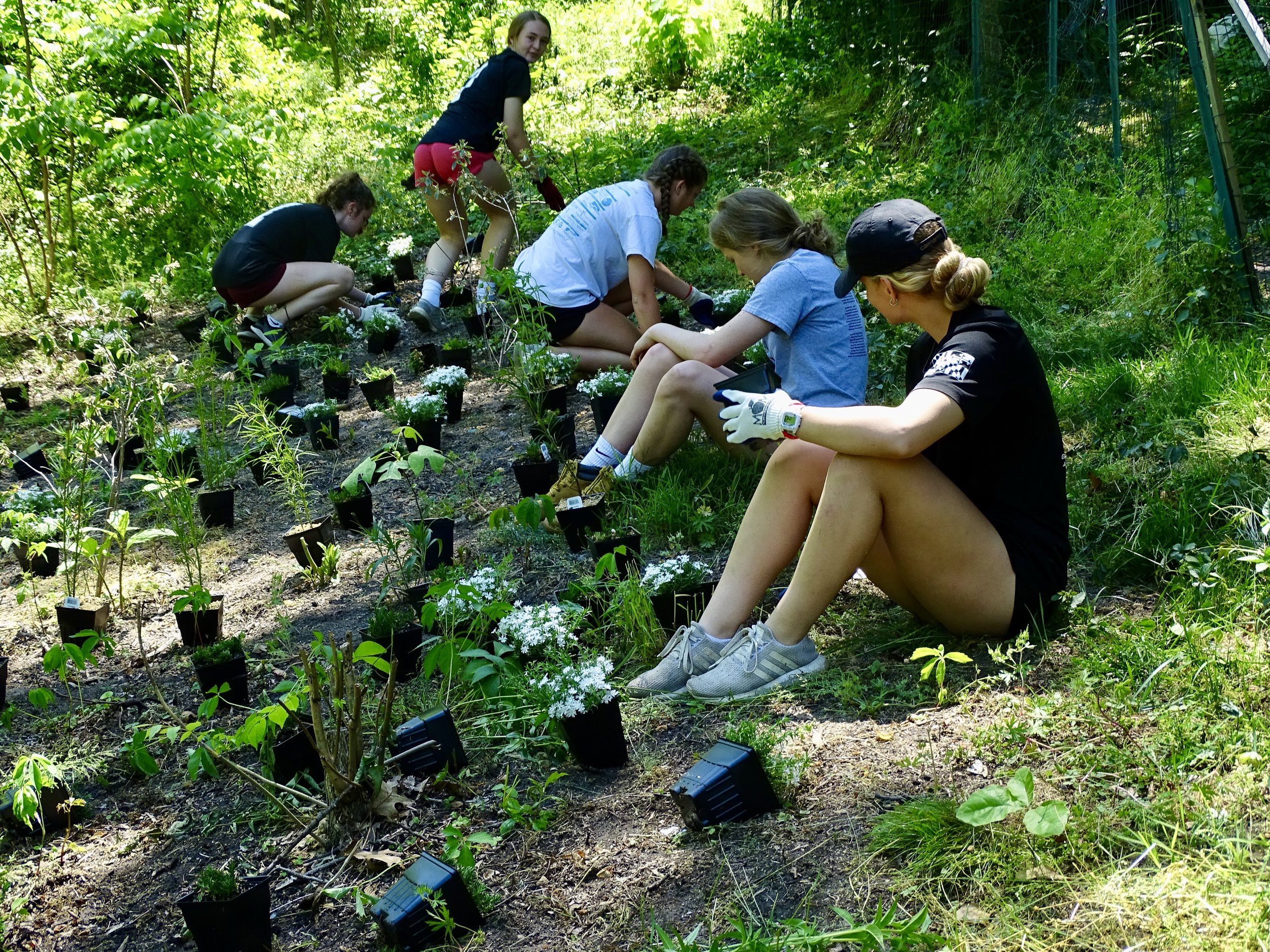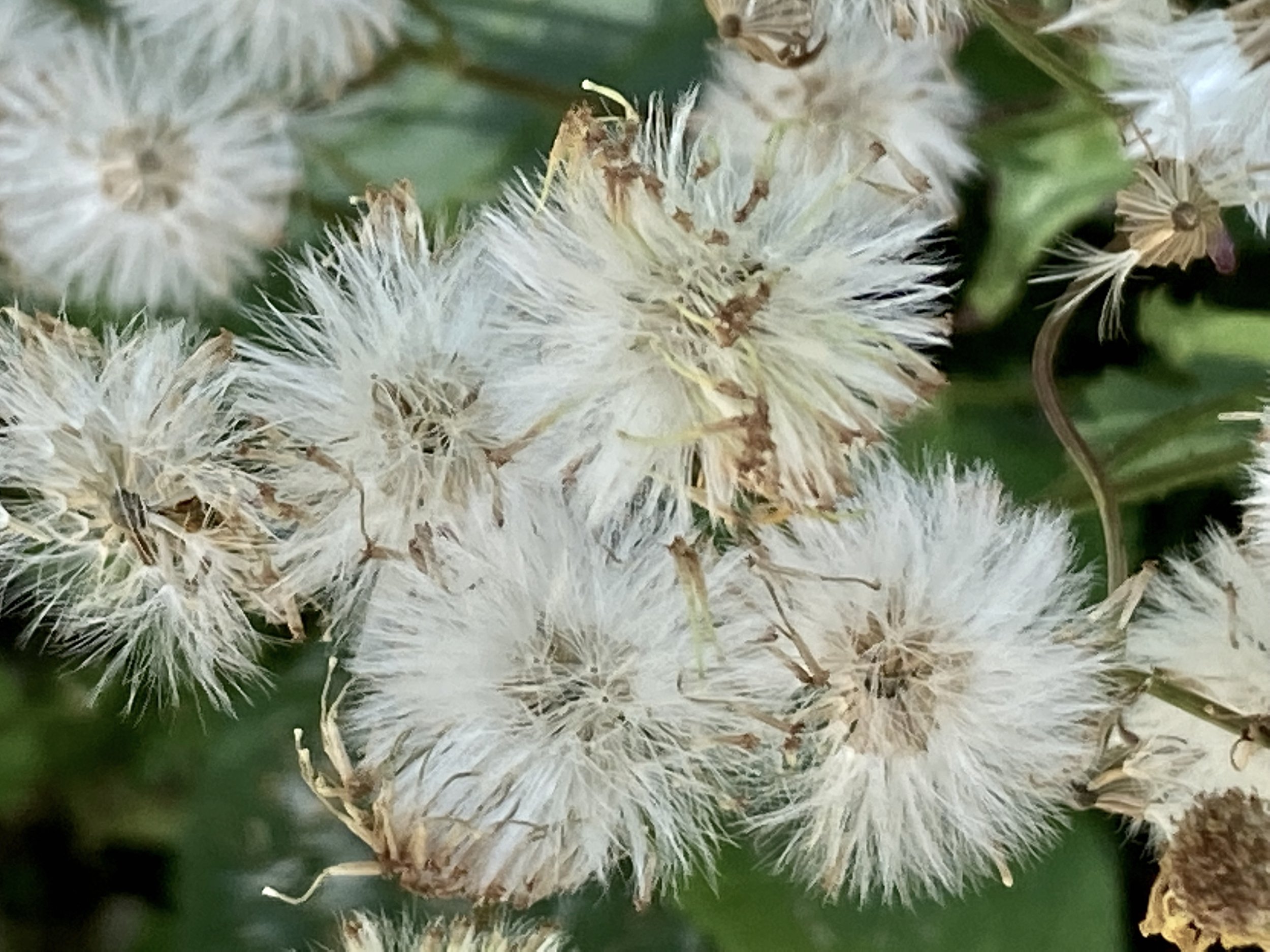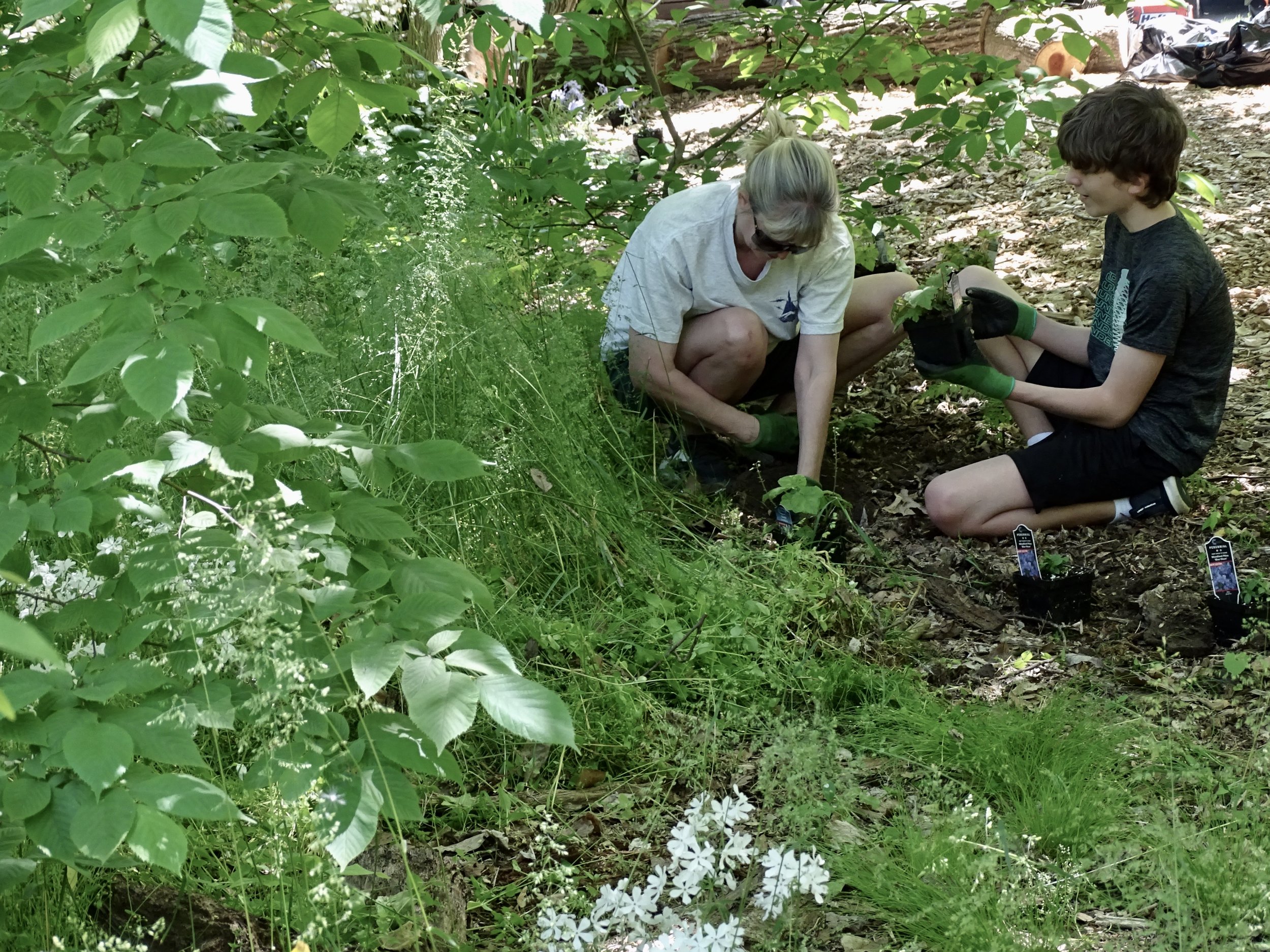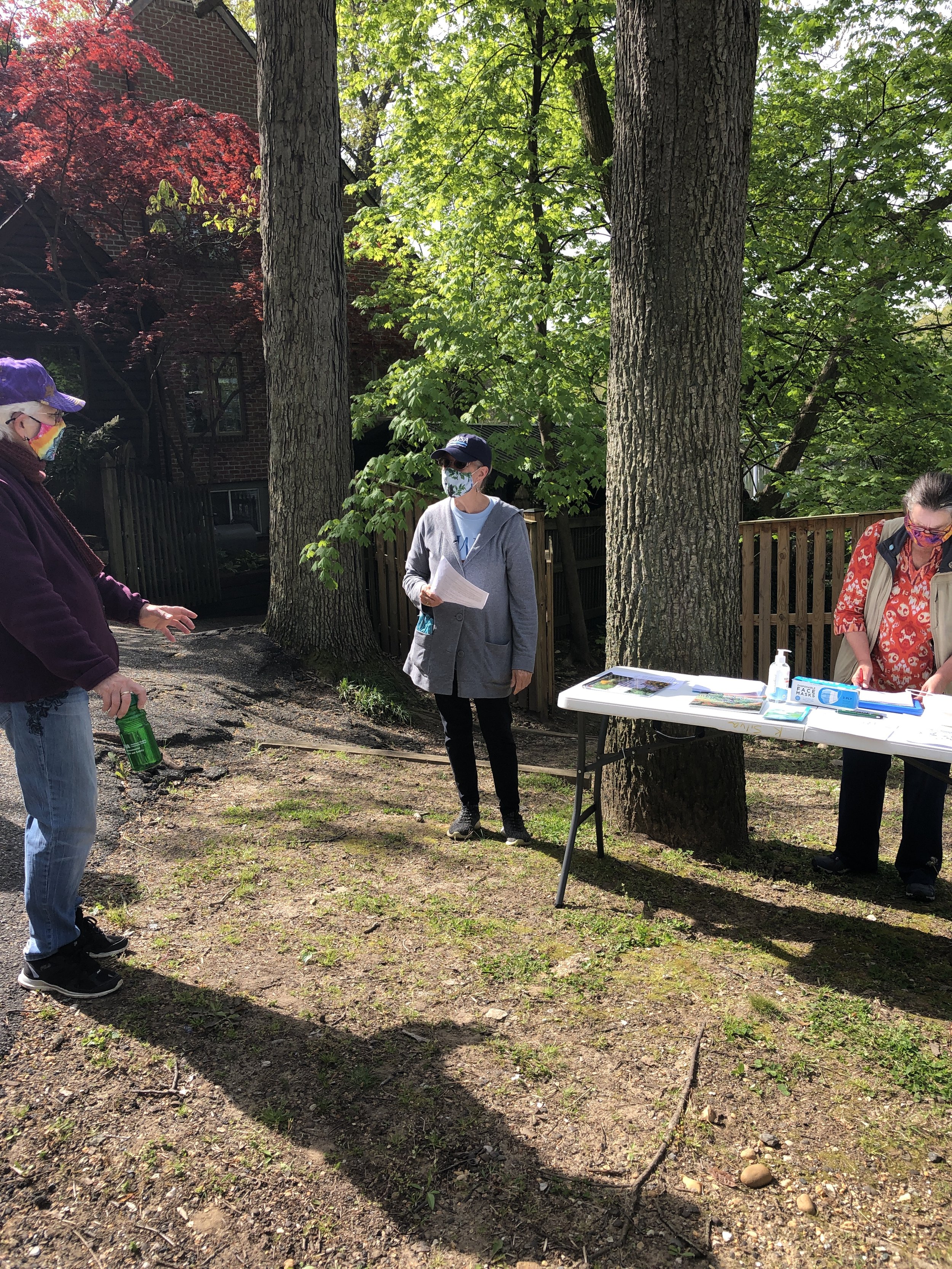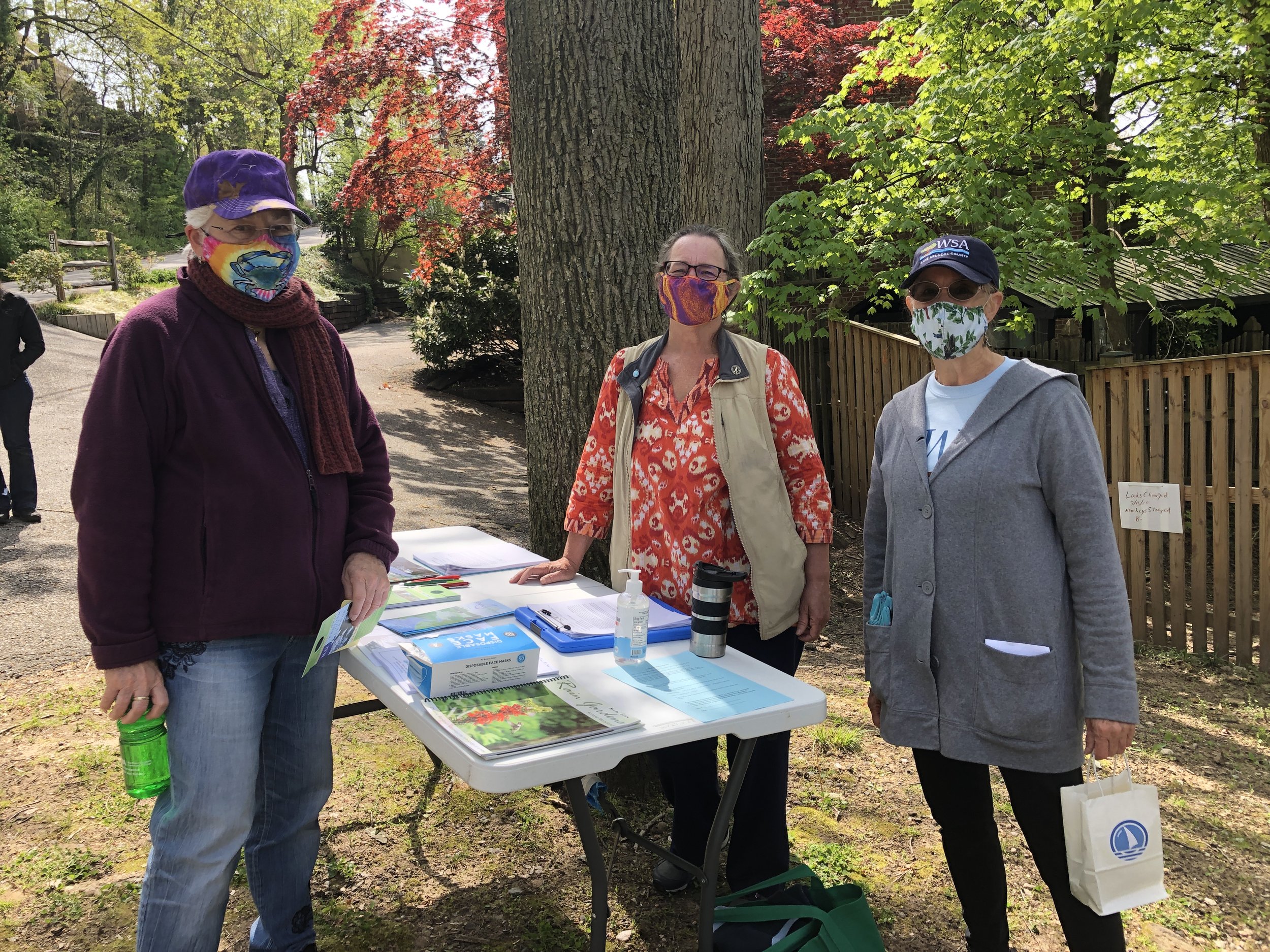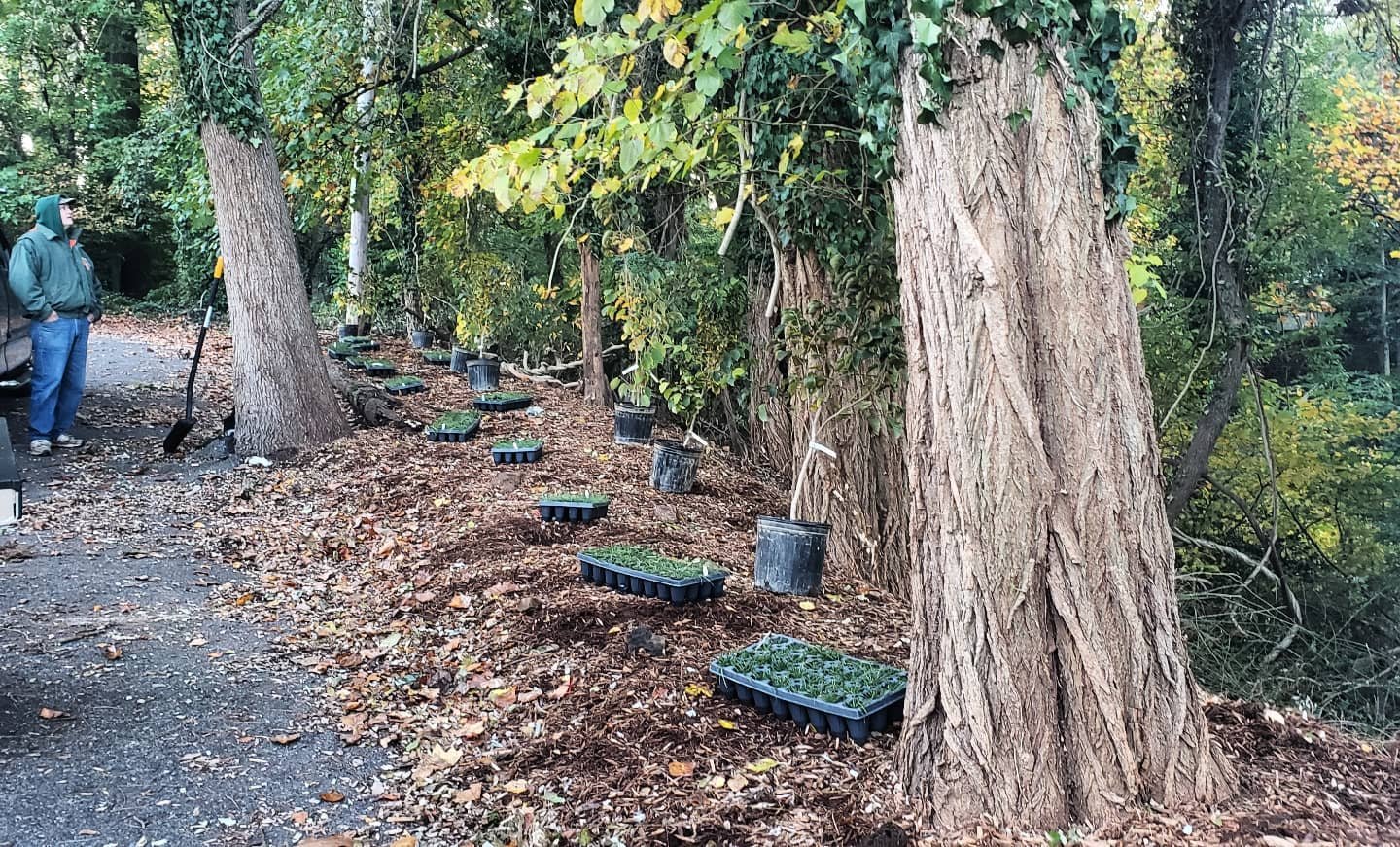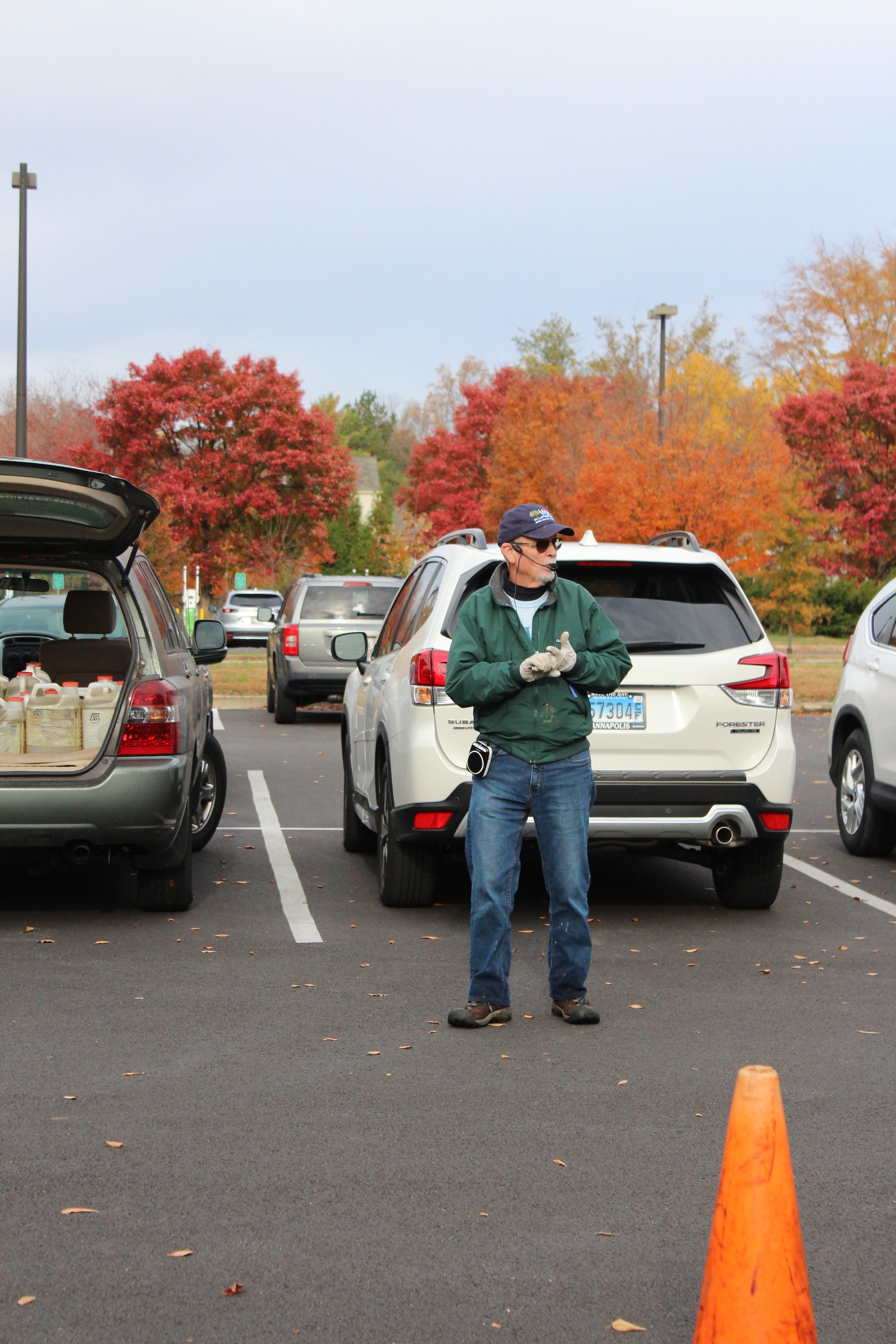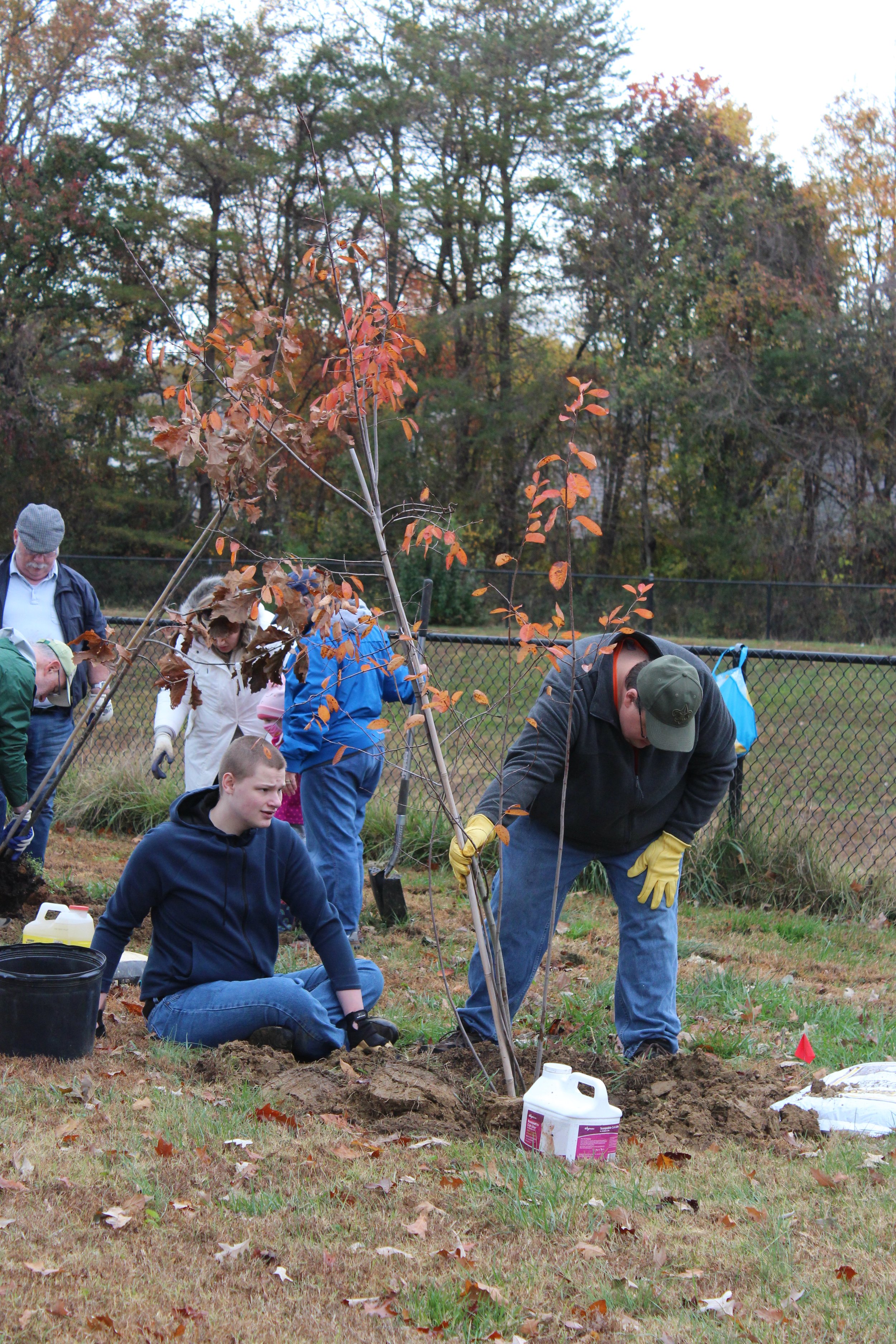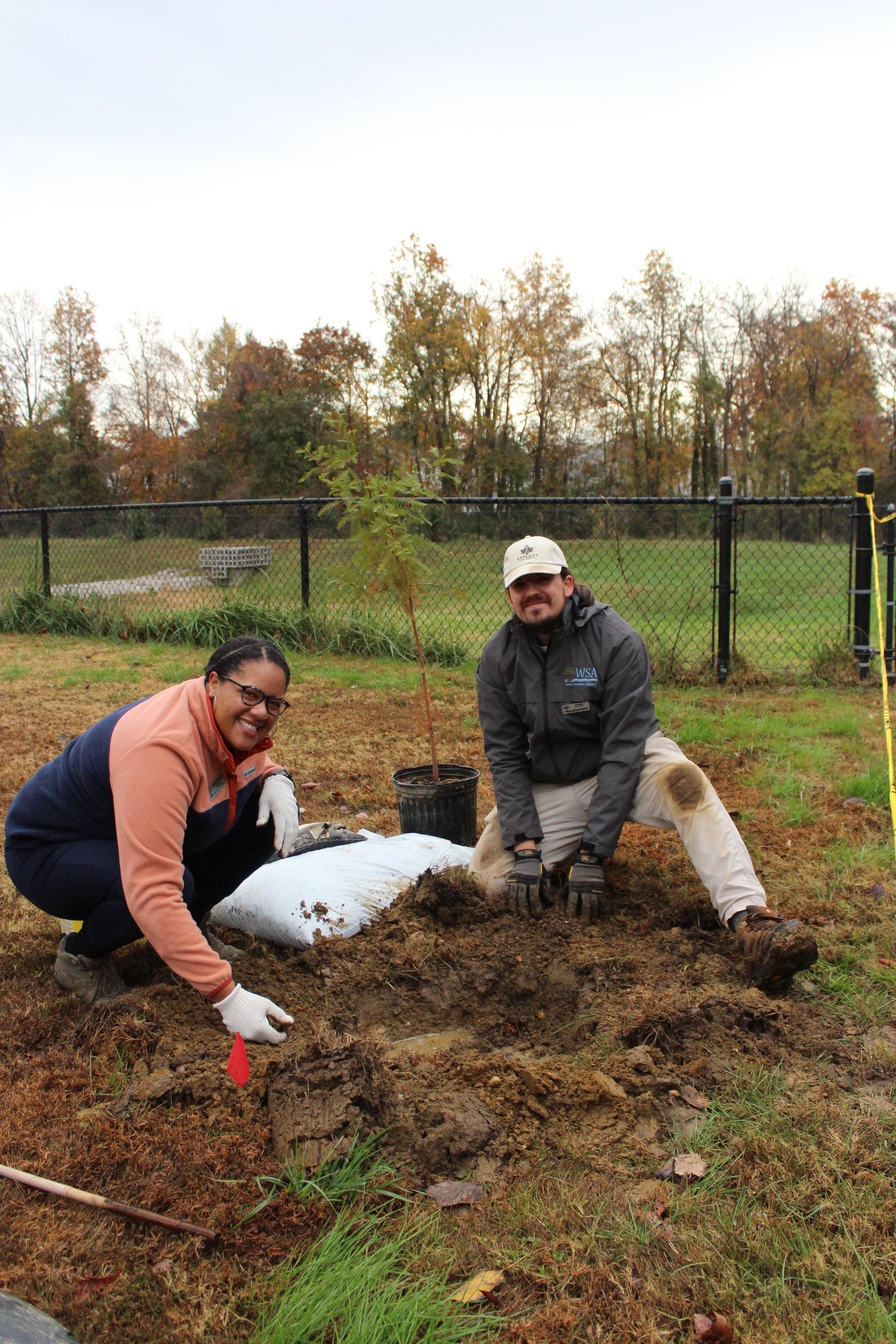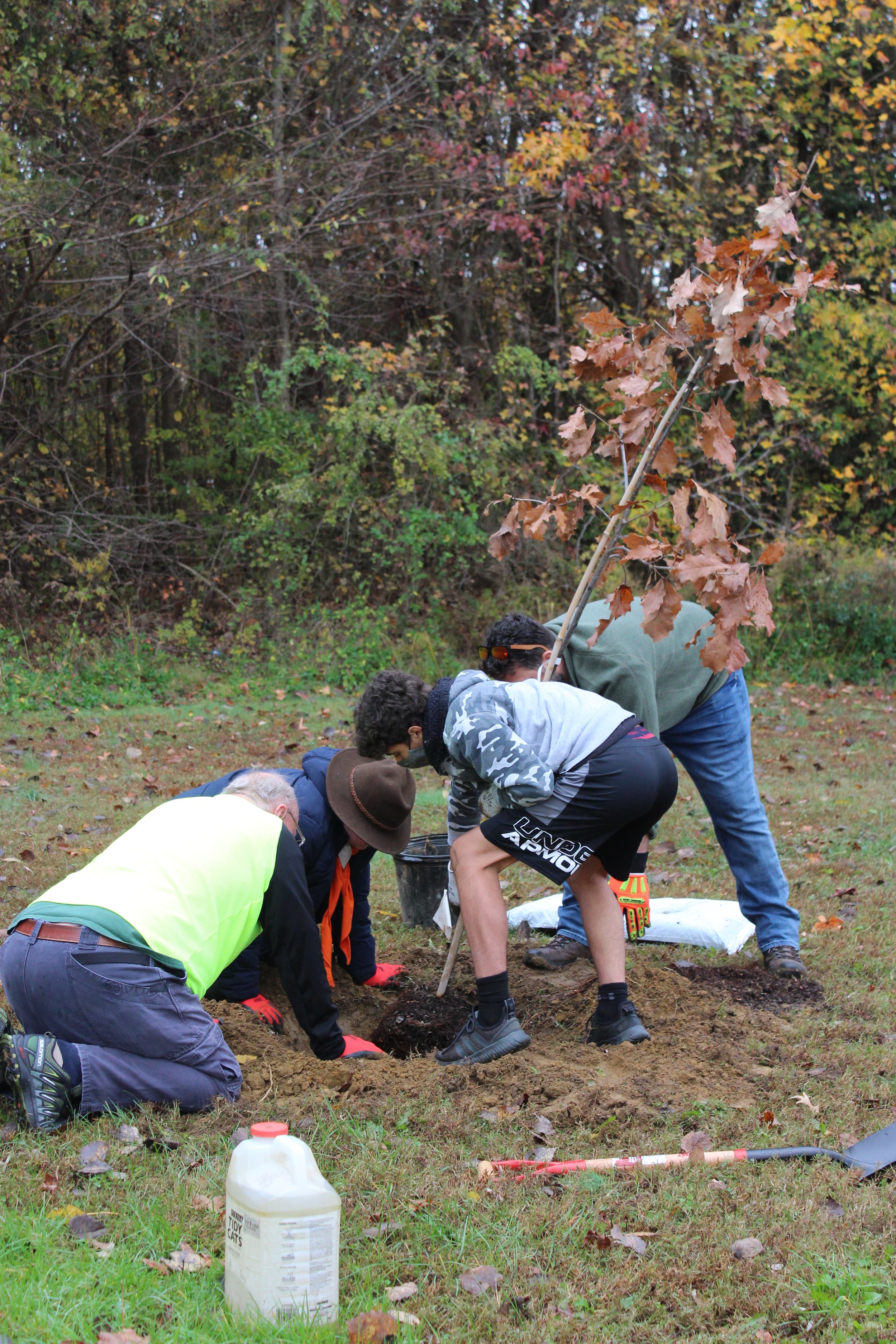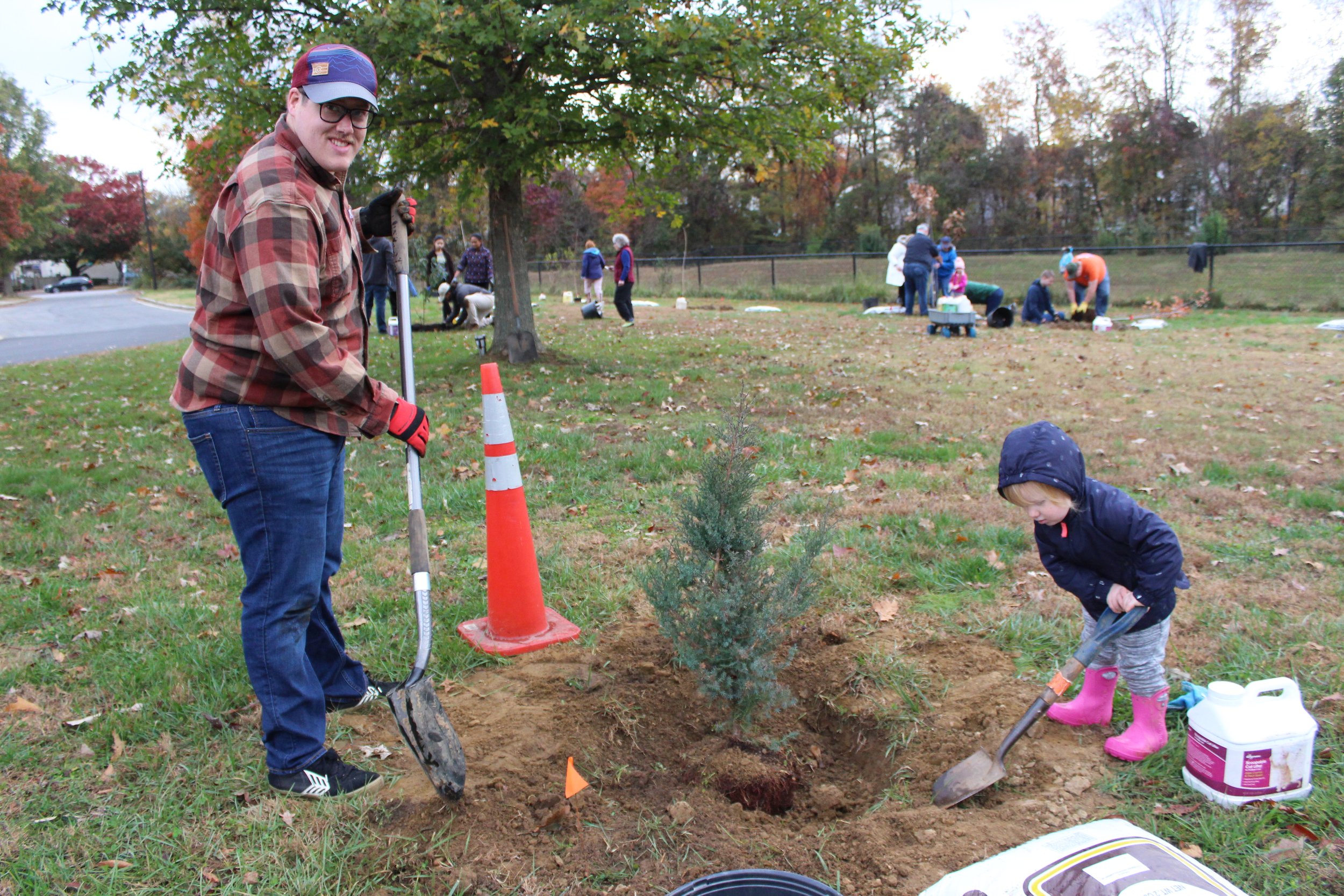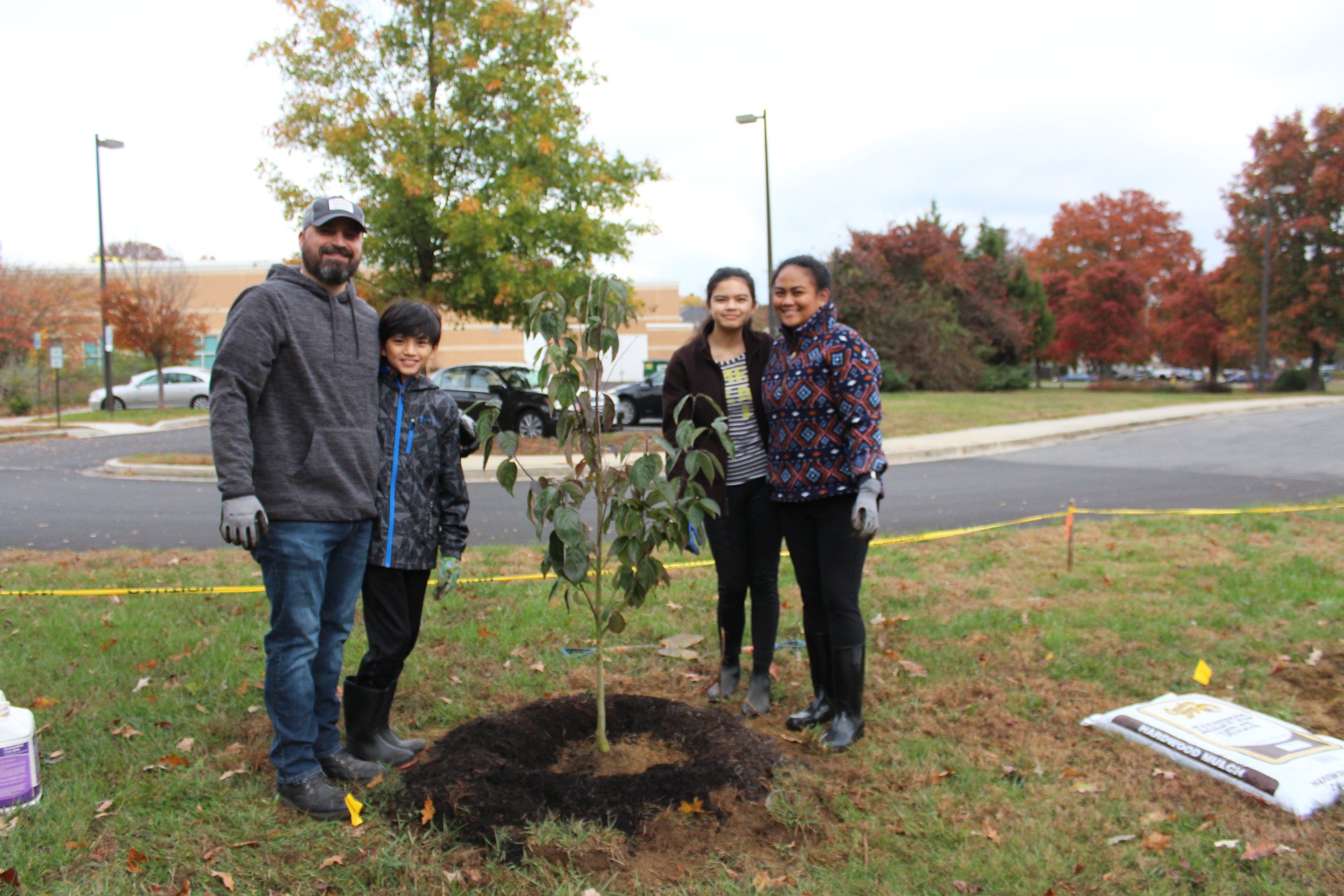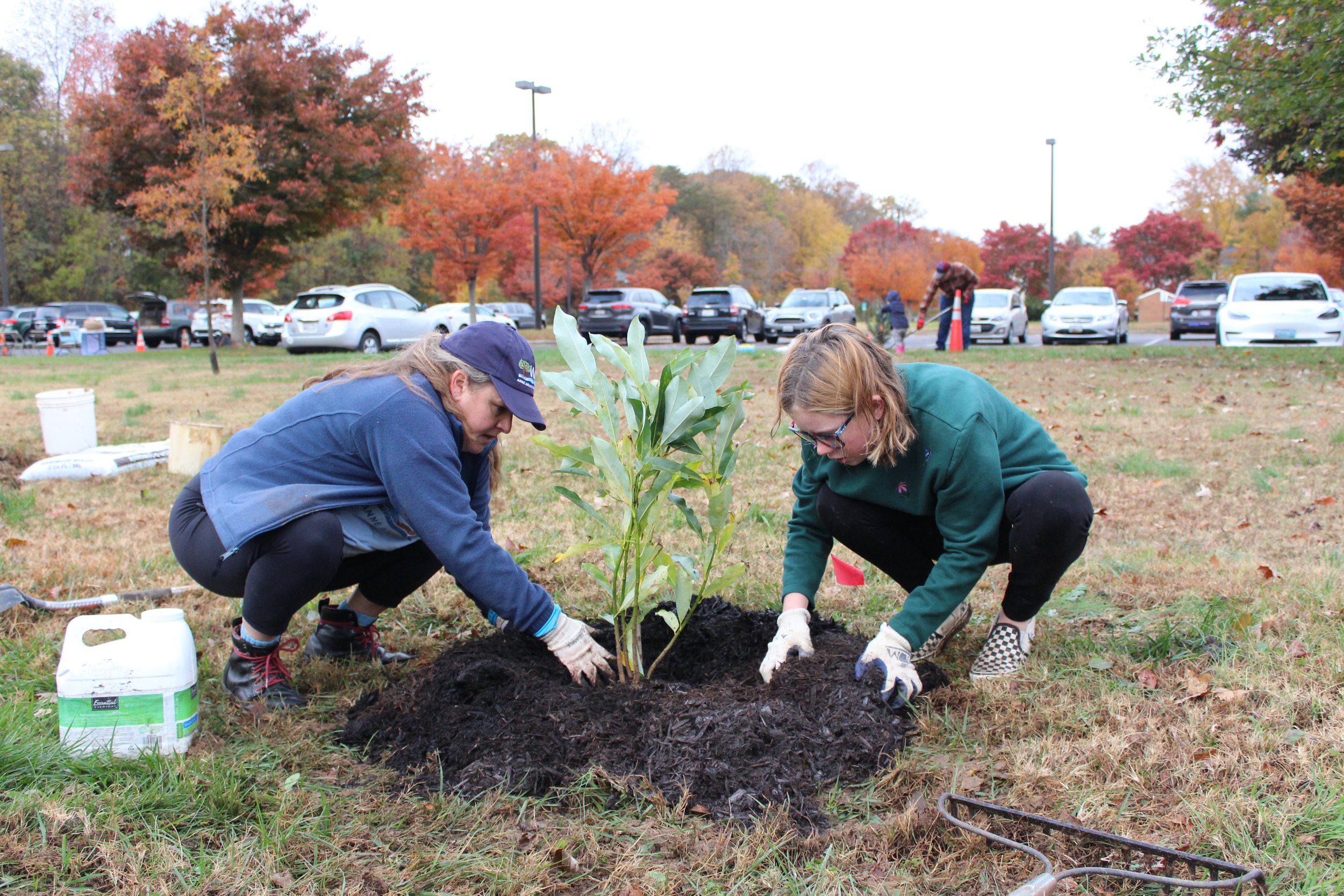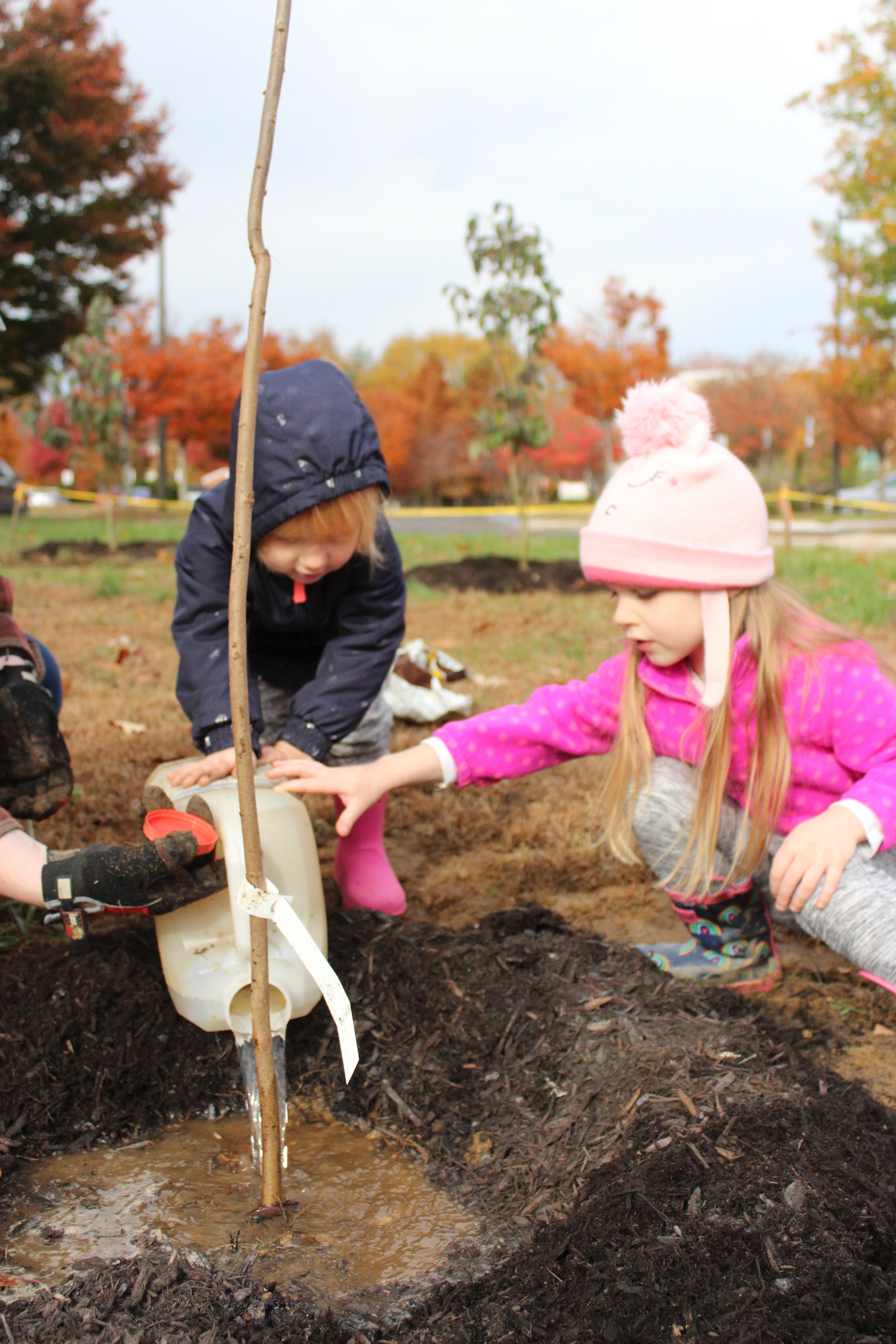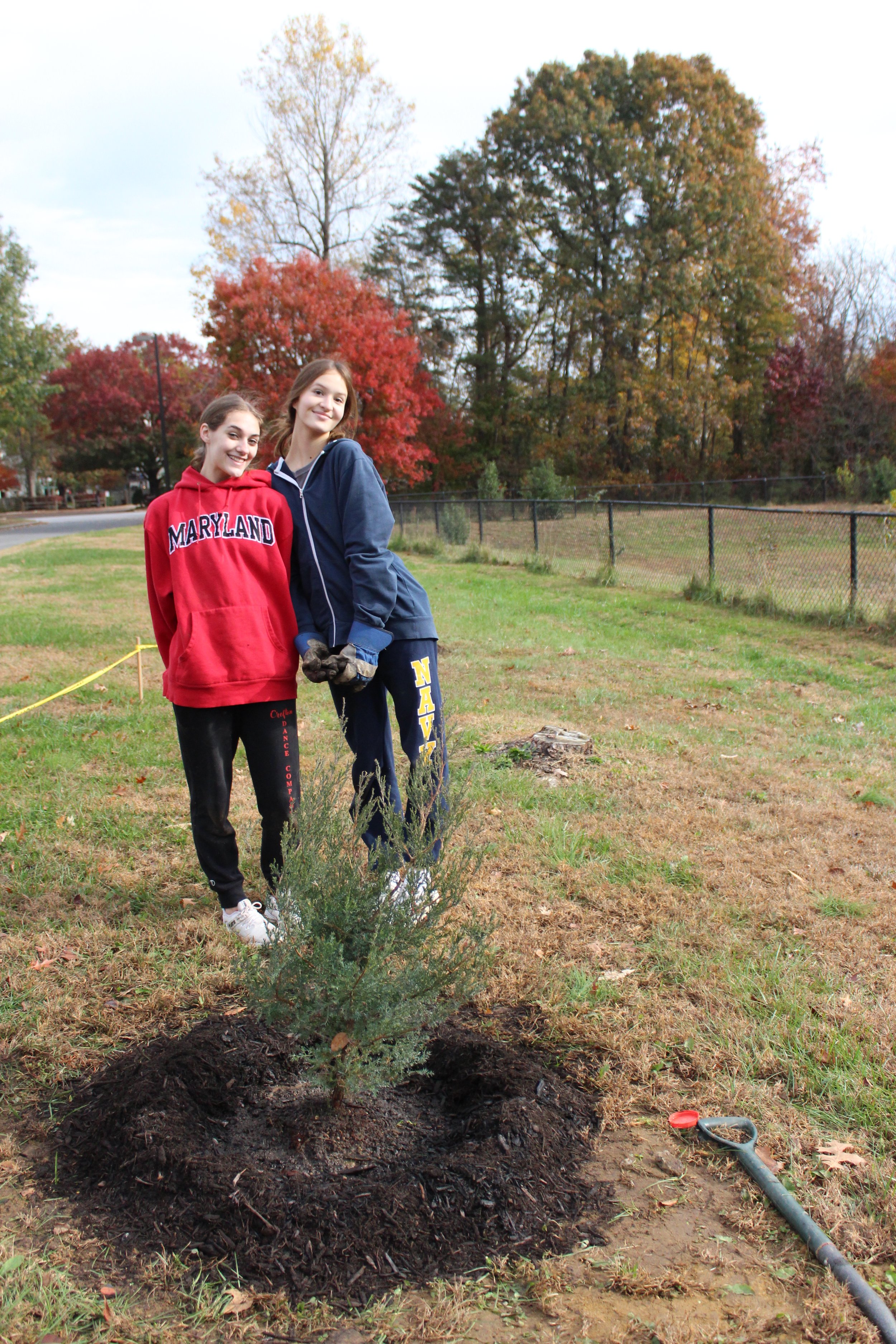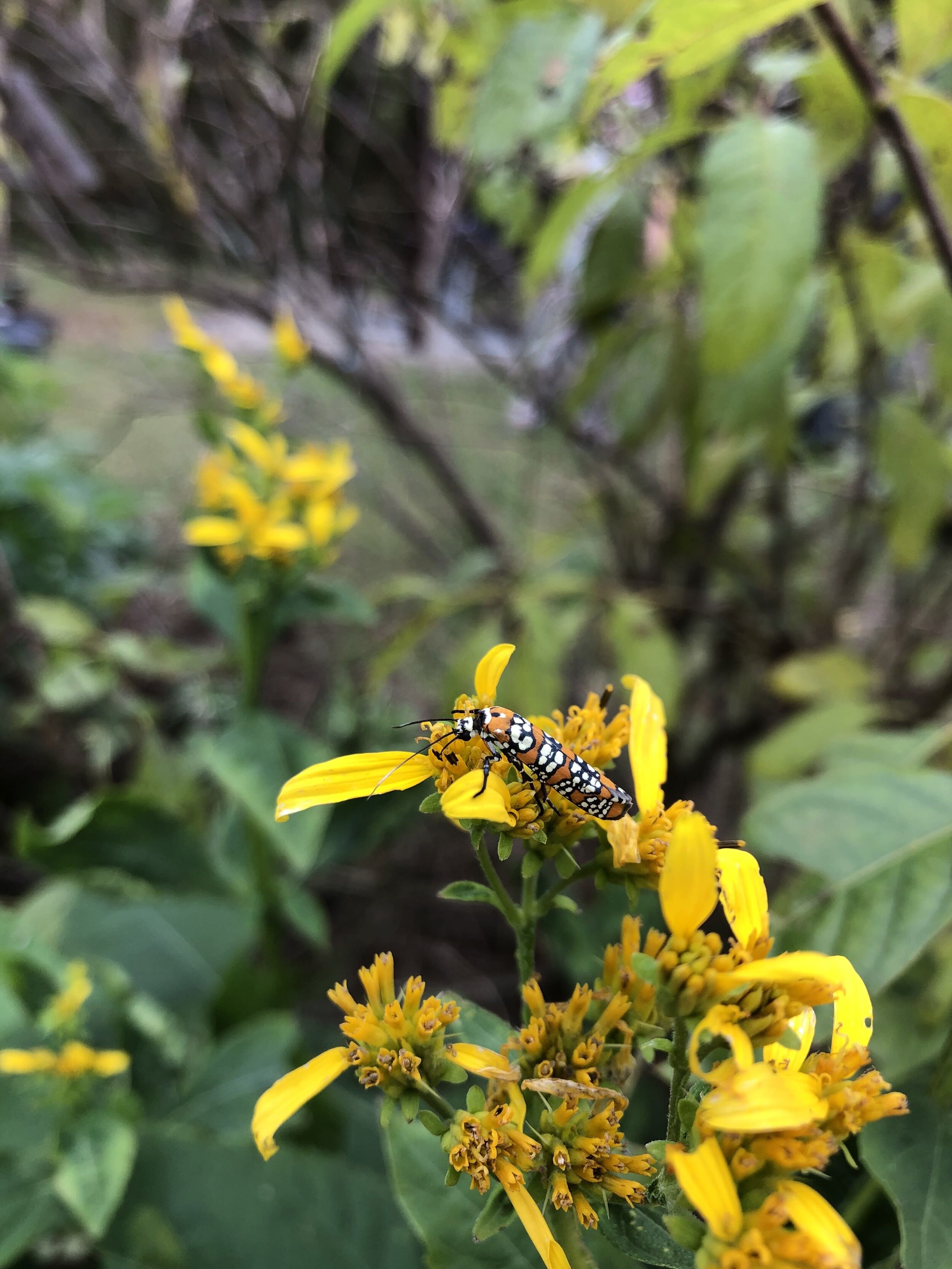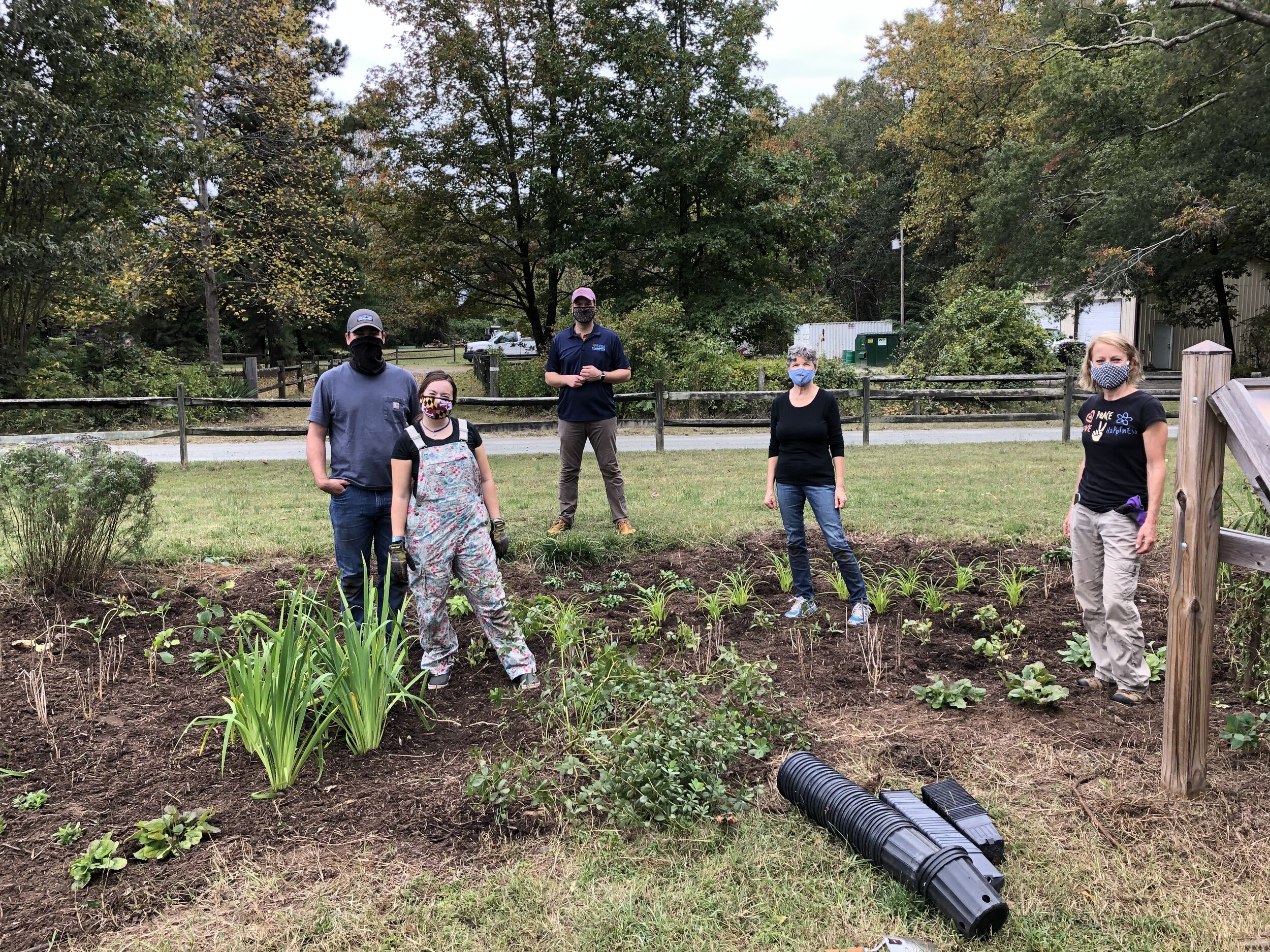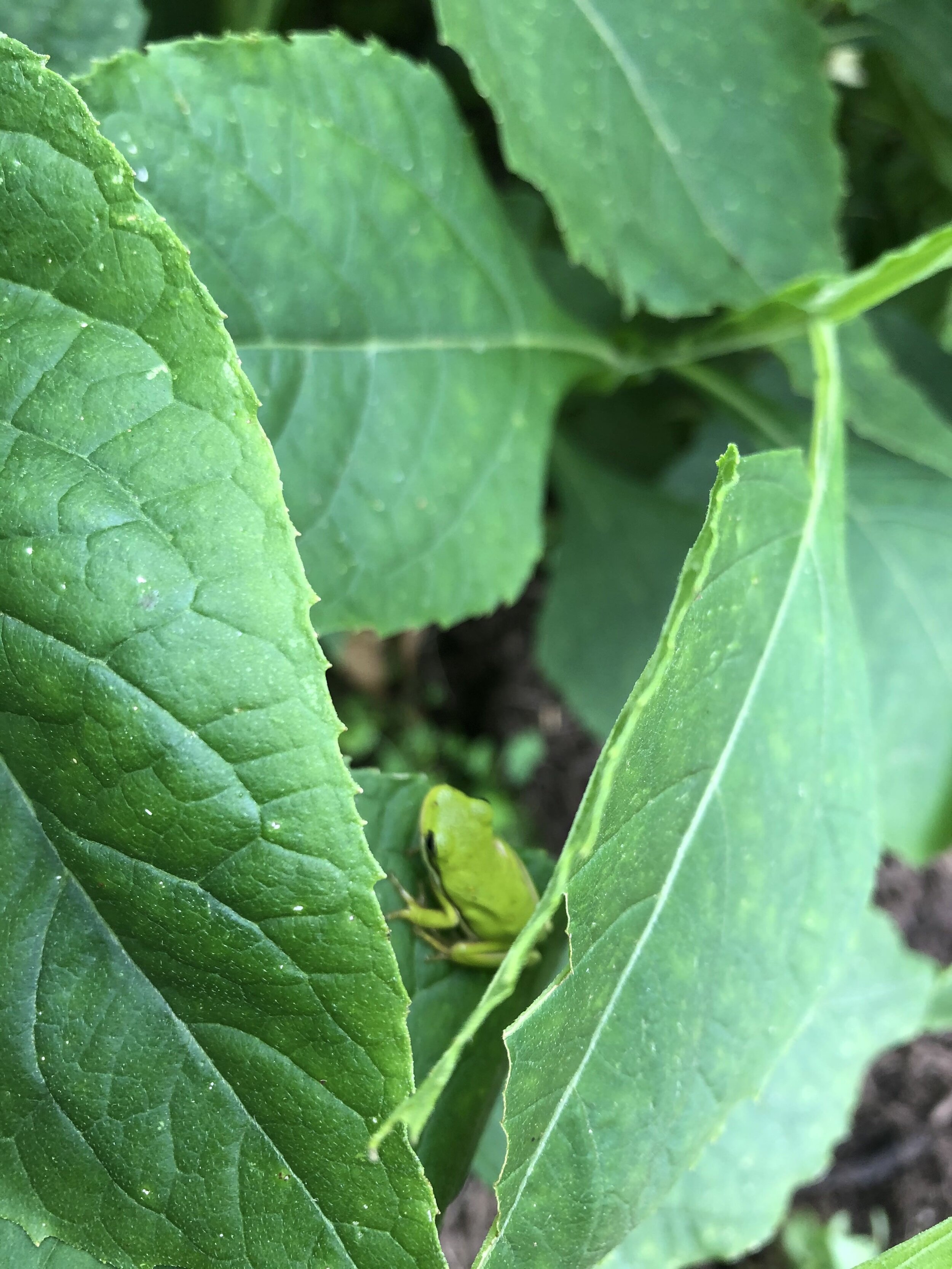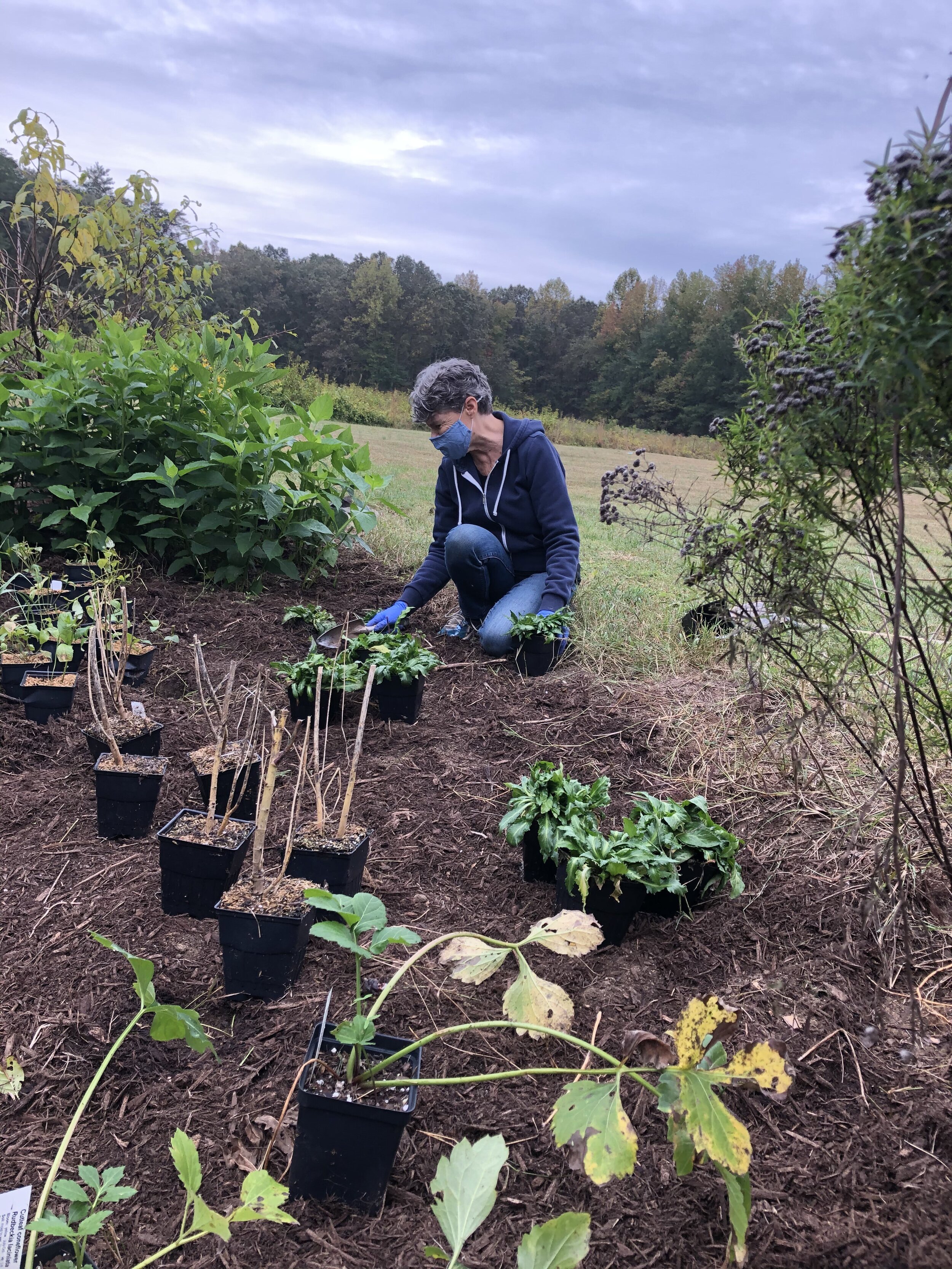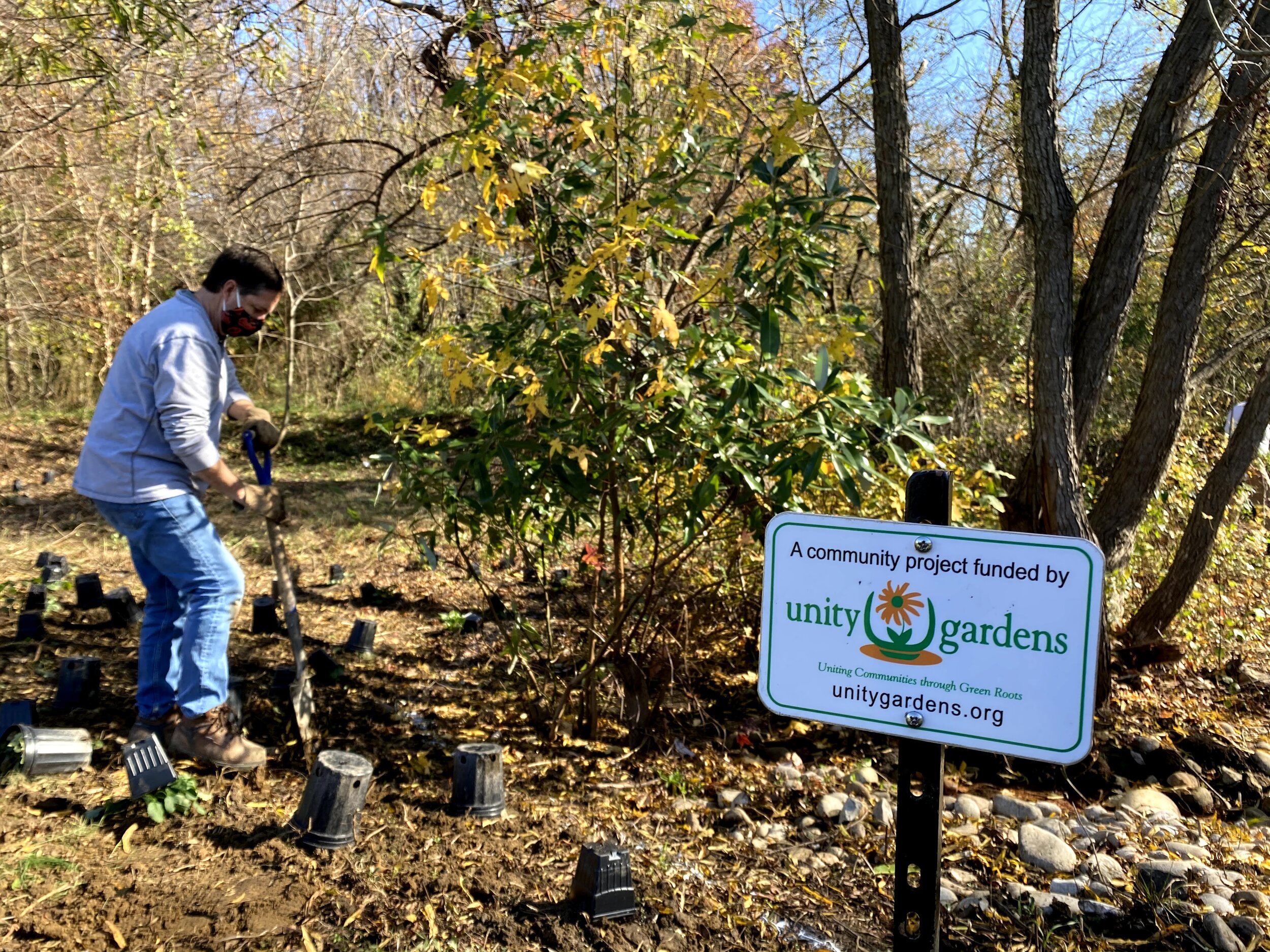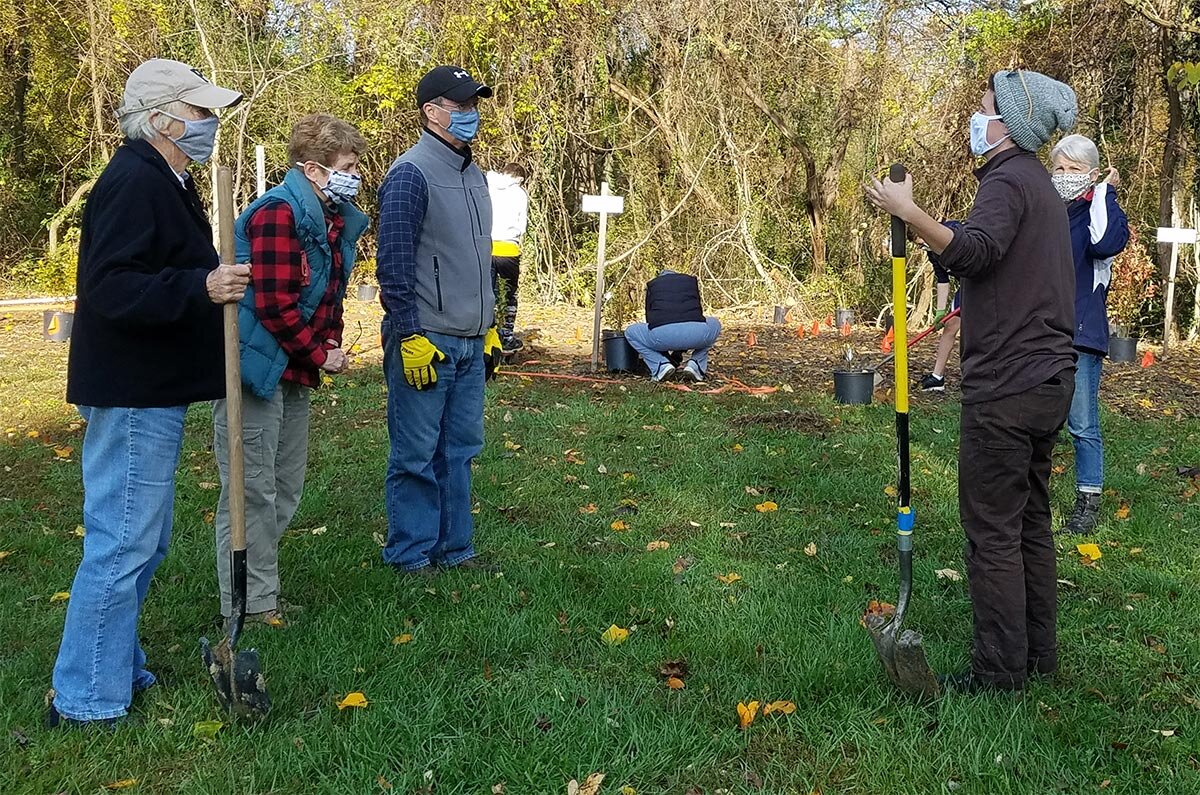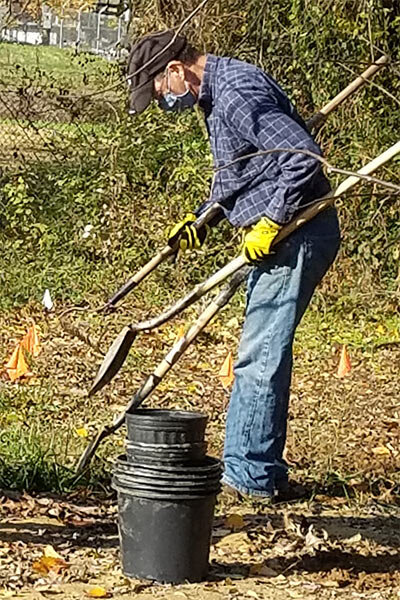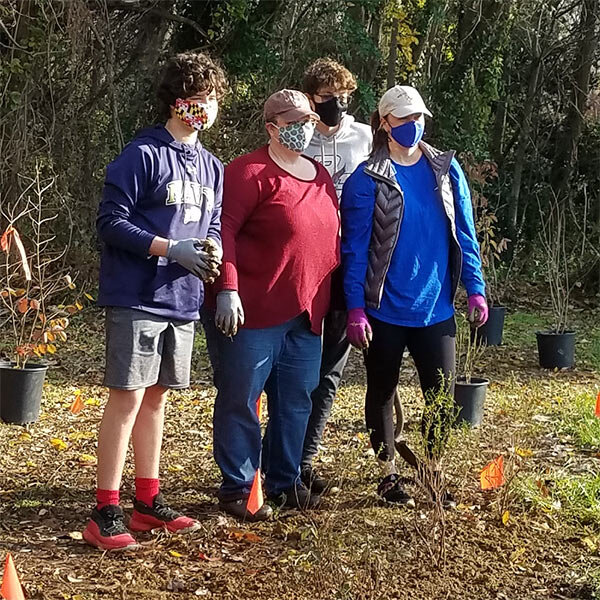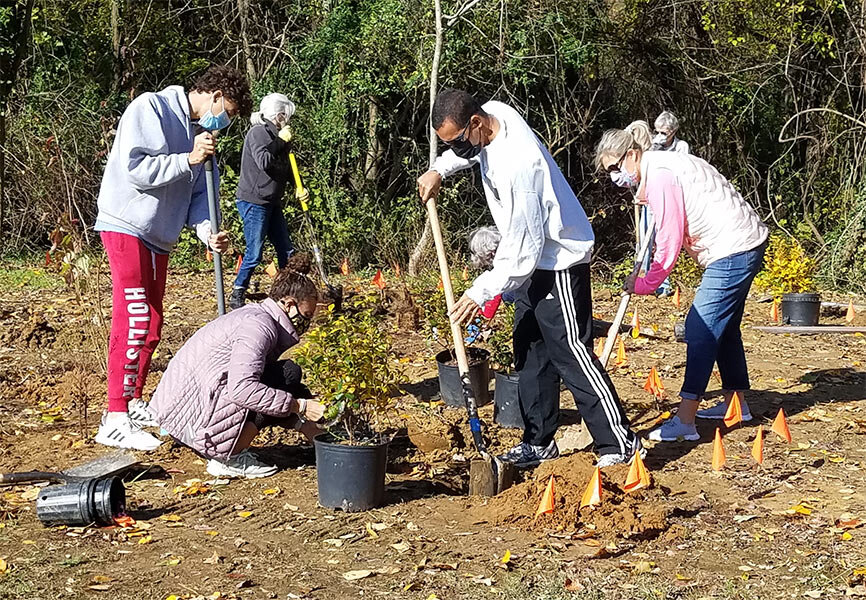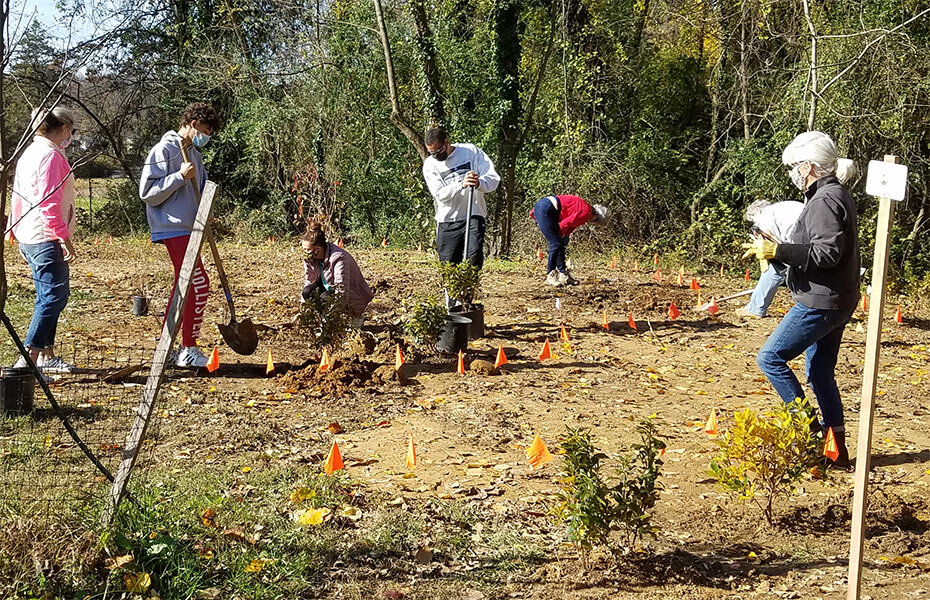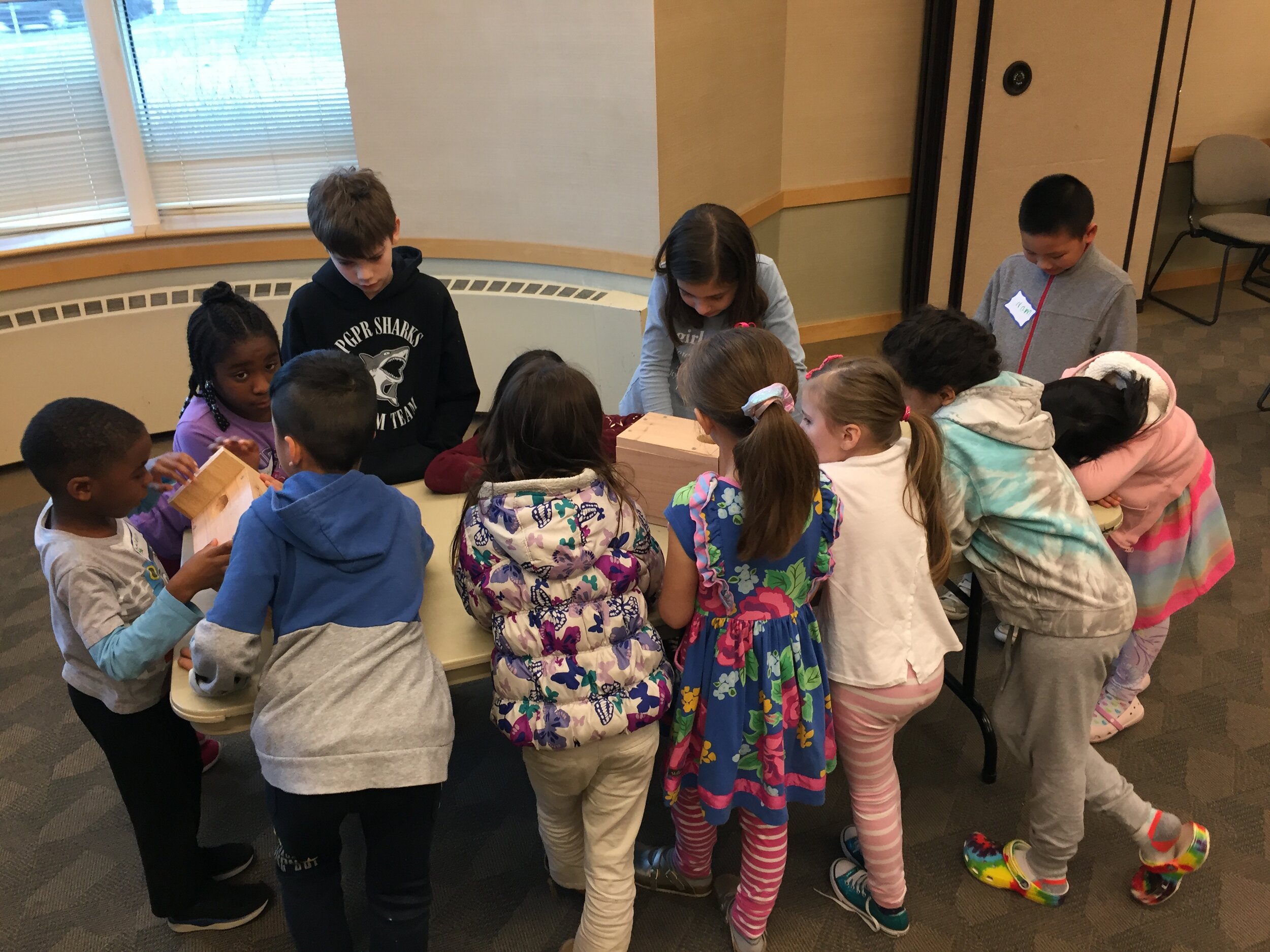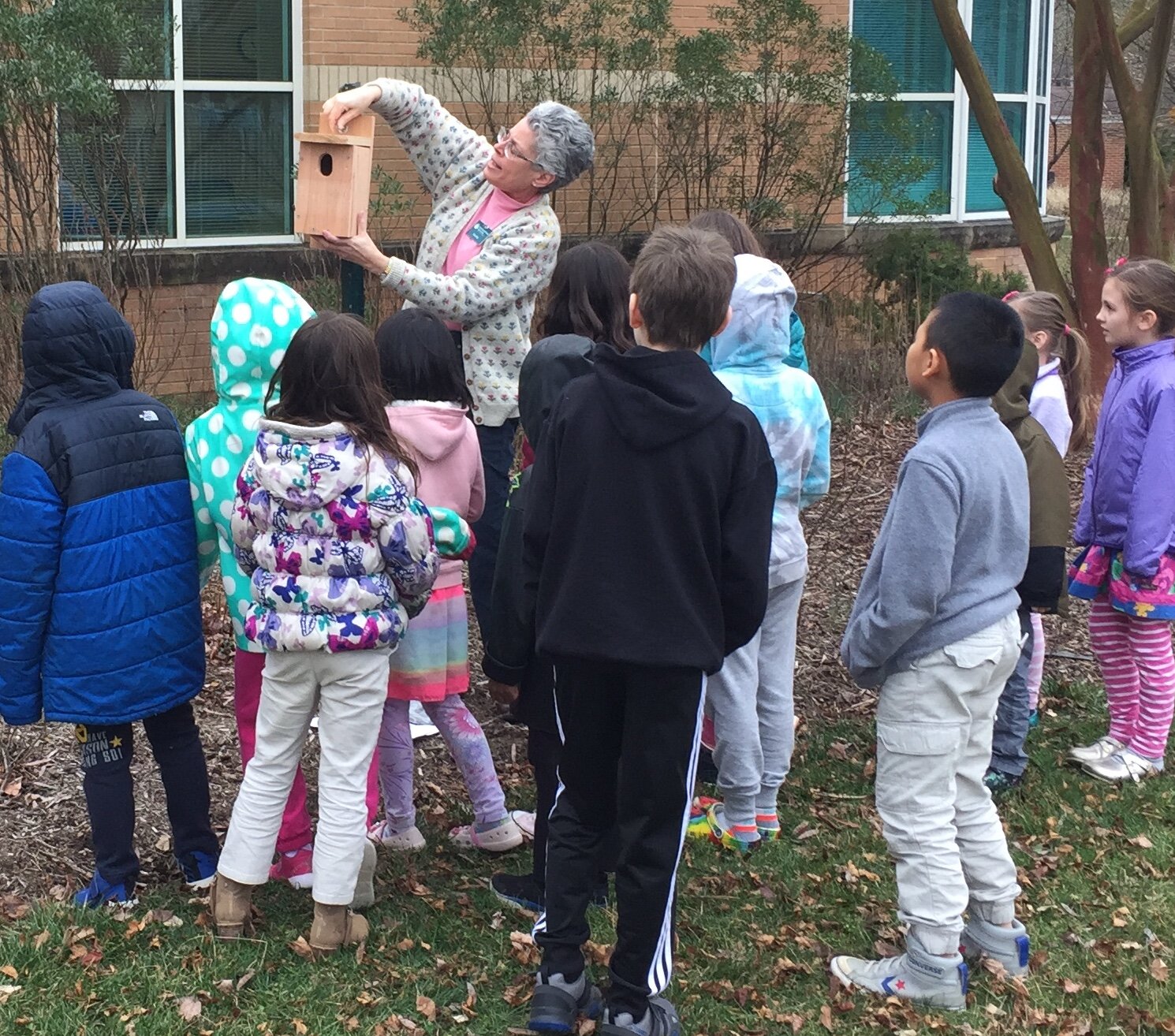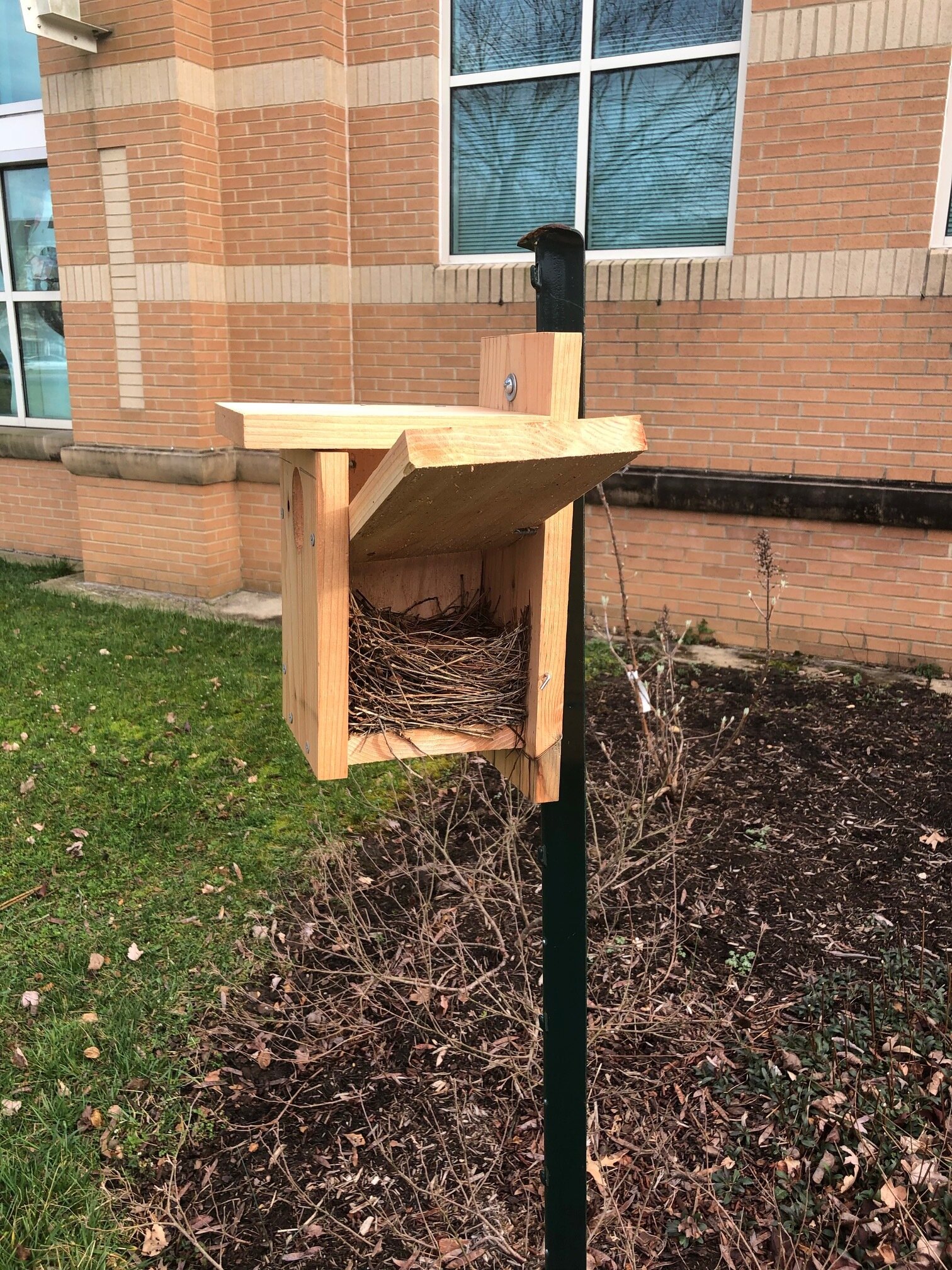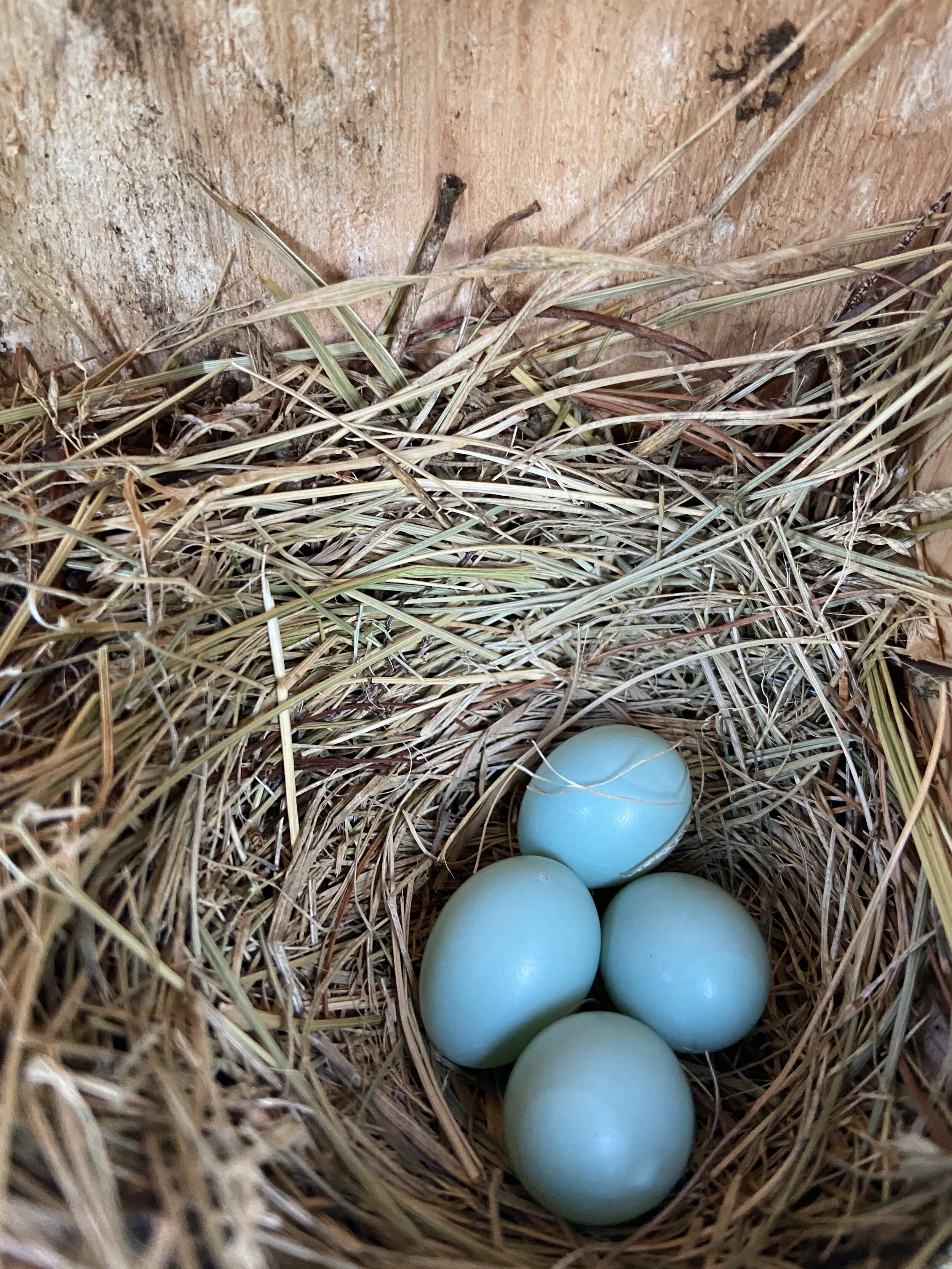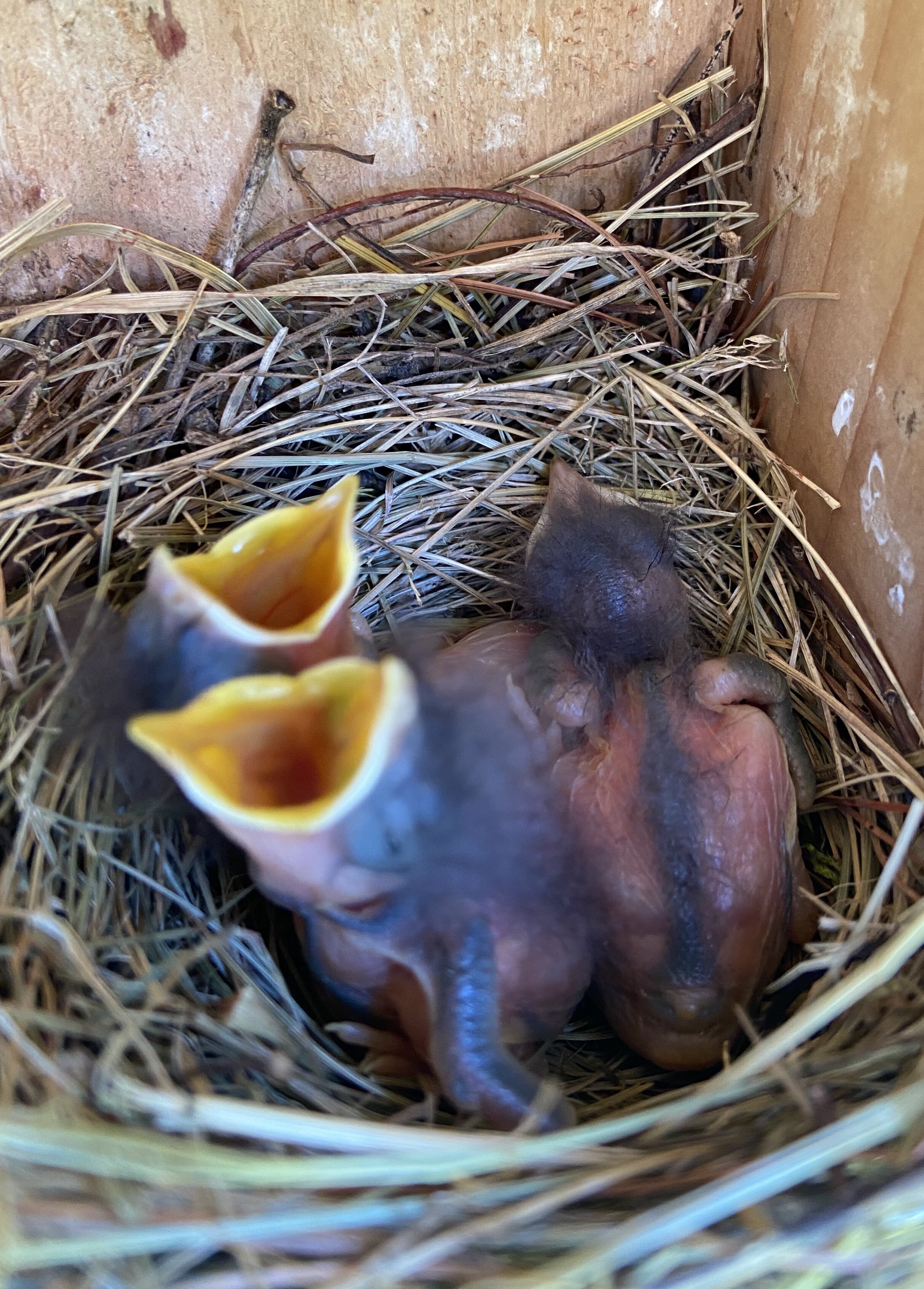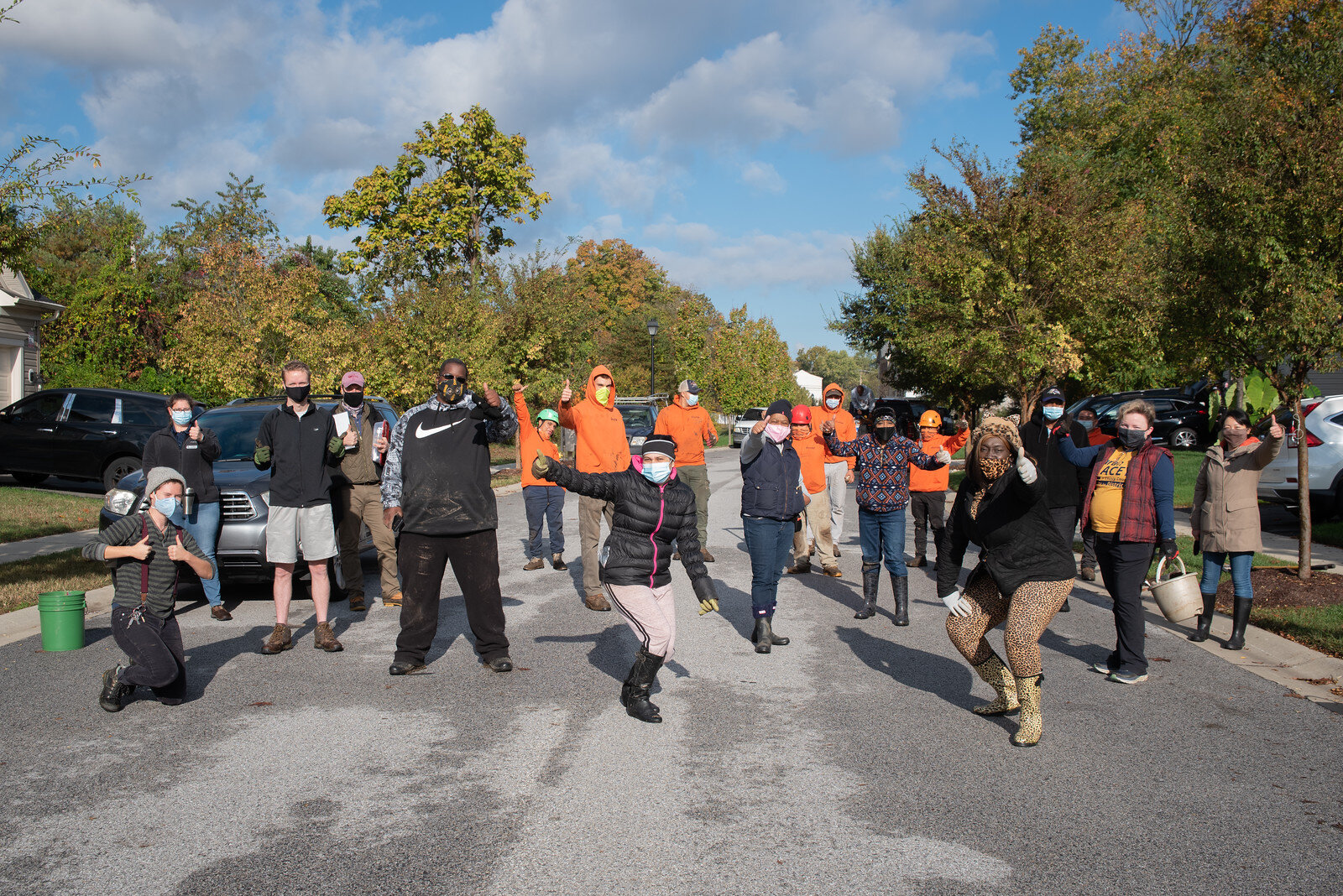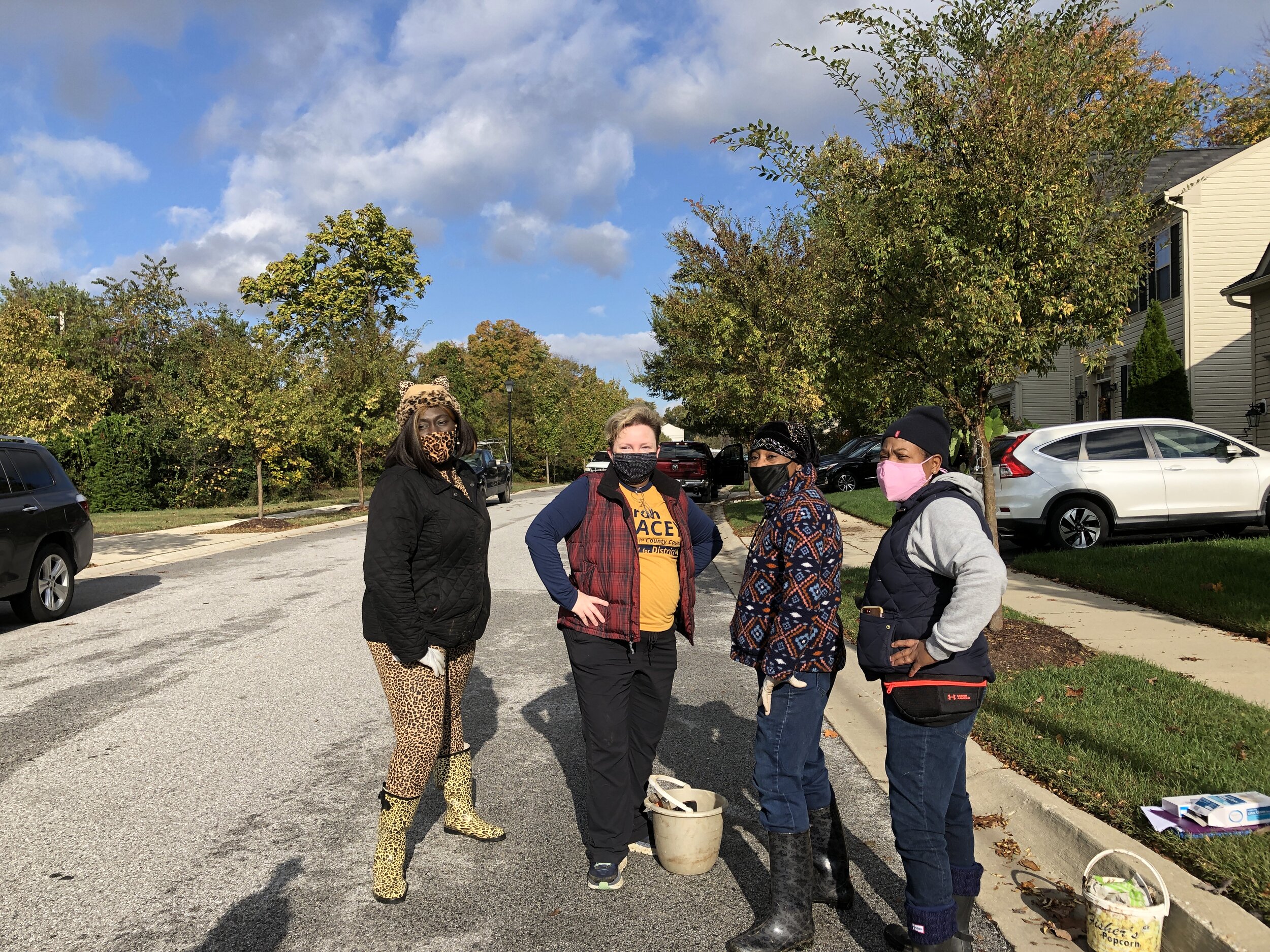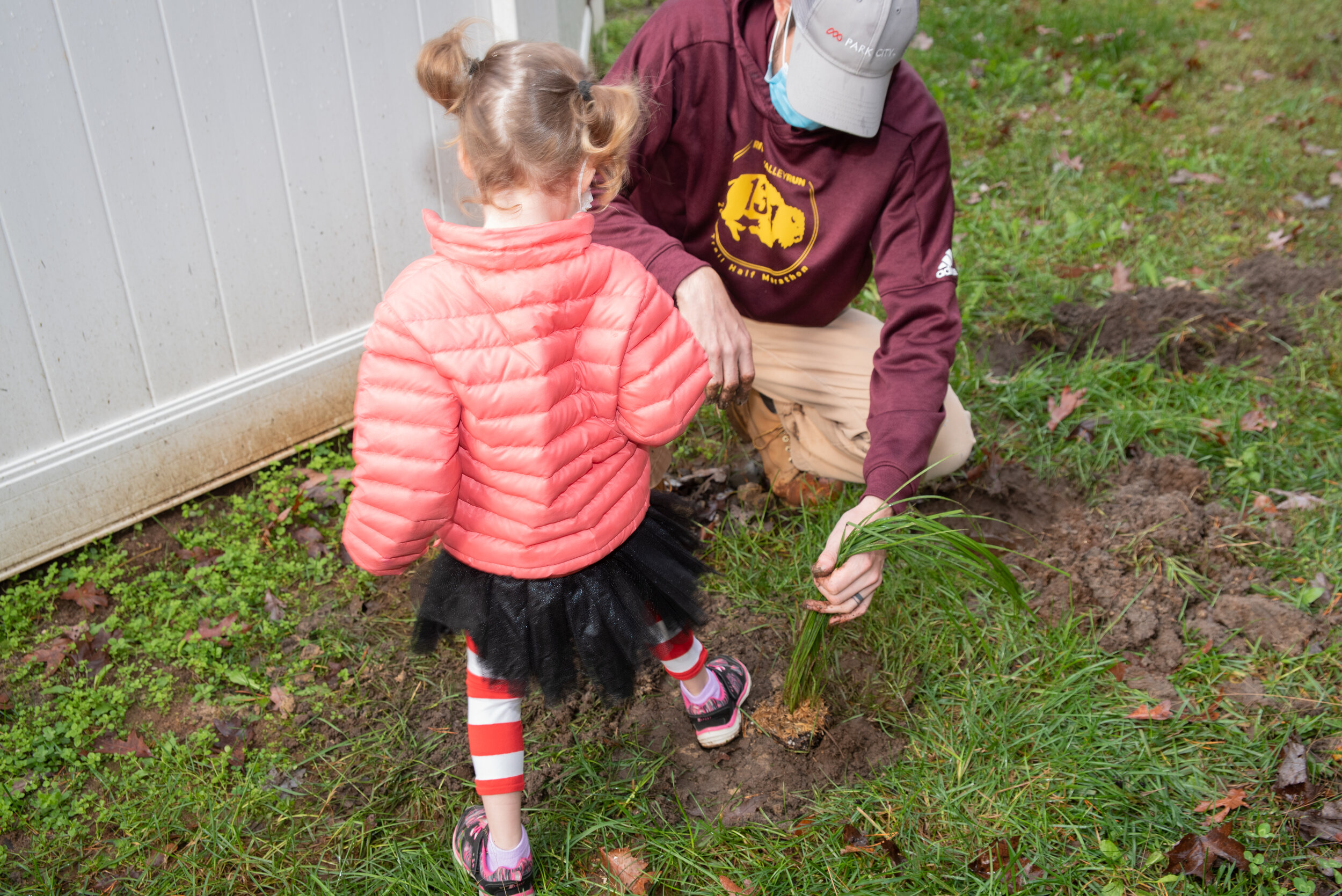Each year, Steward Candidates complete a capstone project as part of the Certification Course. From creating activities to engage students in environmental literacy to planting hundreds of perennials in a conservation landscape, Class 13 Stewards made an impact on clean water throughout the county!
Allison Colden
Project: Invasive removal and conservation landscape planting
Location: Chesapeake Bay Foundation Headquarters ⬝ Severn River Watershed
Allison and her team of CBF staff and community volunteers removed invasive plants from an existing bioretention area on the property and installed a 1,550 square foot conservation landscape consisting of 180 perennials.
Linda Meyer
Project: Community engagement programming
Location: Gravely neighborhood (Davidsonville) ⬝ Severn River Watershed
Linda gathered environmental stewards of all ages for Water, Water, Water and Plants, Plants, Plants! Over the course of two evenings, her neighbors explored the impacts of stormwater and identified native and invasive plants. Through hands-on art and science activities, attendees were inspired to protect and restore the natural resources around them!
Diane Rey
Project: Launched a Green Team with ongoing educational outreach
Location: Christ Our Anchor Presbyterian Church (Cape St. Claire) ⬝ Severn River Watershed
Diane organized her congregation’s Green Team to encourage church members to adopt environmentally friendly habits. Through virtual and in person events, the team inspired over 50 congregants of all ages to to restore, honor, and protect the Chesapeake Bay.
Jenny Janis
Project: Conservation planting
Location: St. Luke’s Restoration of Nature (Annapolis) ⬝ Severn River Watershed
Jenny and her team of volunteers planted over 200 trees and shrubs in a conservation planting at St. Luke’s. The newly installed understory planting will prevent erosion along a sloped trail area while providing food and shelter for the critters who call the restoration home.
Lynette DelPrete
Project: Conservation landscape planting
Location: Maryland City at Russett Public Library (Laurel) ⬝ Little Patuxent Watershed
Lynette and volunteers removed invasives and installed a conservation landscape at the library entrance. Nearly 120 native plants, including Black eyed Susan, smooth blue aster, butterfly weed, and beautyberry will support pollinators, reduce runoff, and promote sustainable landscapes to library visitors of all ages!
Lucy Heller
Project: Rain barrel and conservation landscape installation
Location: Alliance for the Chesapeake Bay (Annapolis) ⬝ Severn River Watershed
Lucy worked with Alliance staff to install a rain barrel and went live on Facebook while doing it! In case you missed it, you can watch it here. Then, she engaged volunteers to plant over 100 native perennials and shrubs in a conservation landscape!
Phyllis Saroff
Project: Neighborhood tree planting
Location: Hillsmere Community (Annapolis) ⬝ Severn River Watershed
Annapolis’ Hillsmere neighborhood is home to 20 newly planted native trees, thanks to Phyllis and her volunteers! Located at a highly trafficked water access point, the trees will soak in stormwater runoff before it enters Duvall Creek.
Meg Kirkendall
Project: Virtual education programming and litter clean up
Location: Odenton Public Library (Odenton) ⬝ Severn River Watershed
Meg coordinated three virtual events on Earth Day, engaging community members of all ages in environmental programming. Attendees were introduced to a vulture and explored other wildlife in their backyards. Inspired by their discoveries, a crew of volunteers joined Meg to clean up trash around Odenton Public Library.
Kate Vogel
Project: Programming for Anne Arundel County Public Library
Location: Annapolis and Crofton Public Libraries ⬝ Severn River and Little Patuxent Watersheds
Kate designed and hosted an environmental literacy program called “What is a Watershed?” for students at two county libraries. Through hands-on activities, the students discovered what makes a watershed healthy and explored the differences between pervious and impervious surfaces. Inspired by their newfound knowledge, the students discussed how to reduce pollution in their own neighborhoods.
Kimberly Stringer
Project: Conservation landscape planting
Location: South Drive (Severna Park) ⬝ Magothy River Watershed
Kimberly planned and installed an expansion of an existing conservation landscape and raingarden in her Severna Park neighborhood. With the help of volunteers, the native plants installed will prevent flooding and standing water, while inspiring neighbors to introduce native plants in their own yards.
Mary Mulvihill
Project: Conservation landscape planting
Location: Beechwood Hill (Annapolis) ⬝ Severn and South River Watersheds
Mary and her community installed a conservation landscape at the community’s main entrance. The highly visible location demonstrates how native shrubs, grasses, and perennials can redress slope and soil erosion caused by stormwater runoff; replaces compacted turf grass to allow better stormwater infiltration; provides habitat; and beautifies property grounds.
Stacey Wildberger
Project: Conservation landscape planting
Location: Cape St. Claire (Annapolis) ⬝ Magothy River Watershed
Stacey and her army of volunteers planted nearly 400 native perennials and shrubs in the community’s “Serene Ravine.” Through her efforts, neighbors experience the increase in biodiversity in their neighborhood and are inspired to take action in their own yards.
Kristin Silva
Project: Community outreach programming
Location: Carrolton Manor (Severna Park) ⬝ Severn River Watershed
Kristin designed an outreach program to create awareness of the local environment and the ways her neighbors can make even small changes in their homes and gardens to improve water quality on the Severn River. Kristin’s first event focused on the community’s tree canopy and the impact of English ivy. Kristin continues to engage her neighbors in environmental action through programs on composting, rain barrels, stormwater runoff and native plants.
Stacy Allen
Project: Tree planting
Location: Holland Point ⬝ Herring Bay Watershed
Stacy took on a project in her community of Holland Point, in the southern most part of the County. She planted 20 trees across a community lot to increase the canopy cover and wildlife value of the area, recruiting an enthusiastic group of volunteers to help out on the Veteran’s Day planting event.
Diane Hill
Project: Tree planting
Location: Coventry 2 Community (Crofton) and Baldwin Hills Swim Club (Millersville)
Diane utilized her position as a leader on her community HOA to plant 14 trees in Coventry in Crofton and 2 trees at the Baldwin Hills Swim Club. She also worked with county officials to approve 18 additional trees that will be planted by a contractor in the same community, on an adjacent county owned floodplain.
Jeanne Martin
Project: Invasive removal and conservation landscape planting
Location: Cape St. Claire (Annapolis) ⬝ Magothy River Watershed
Jeanne and her community removed almost 1100 square feet of invasive species at their community boat launch in Cape St. Claire. She then organized a tree planting of 20 native trees and over 800 native sedges to stabilize the bank along the boat launch’s parking lot.
Jim MacNicholl
Project: Community tree planting
Location: Community Library (Crofton) ⬝ Little Patuxent Watershed
Jim partnered with the Crofton Library Branch to organize and implement a community led planting event. Over 40 volunteers learned about the benefits of native trees, then planted 20 on the grounds of the library.
Nancy Evans
Project: Invasive removal and native plant installation
Location: St. Anne’s Cemetery (Annapolis) ⬝ Severn River Watershed
Nancy teamed up with a congregational group to remove almost 4500 square feet of invasive species at the historic St. Anne’s Cemetery in Annapolis. She then worked to install almost 200 native plants that will become a centerpiece for the cemetery’s new columbarium.
Marie Del Bianco
Project: Invasive removal and native plant installation
Location: Loch Haven (Edgewater) ⬝ South River Watershed
Marie engaged her community of Loch Haven in Edgewater to remove over 2000 square feet of invasive species from a community shoreline. She then worked to install over 400 native plants to stabilize the area.
Elizabeth Ley
Project: English Ivy removal
Location: Witherinsea (Riva) ⬝ South River Watershed
Liz engaged her community of Withernsea in a canopy crusade! Her capstone saved community trees from English ivy through rings of life. She is also planning on planting resilient native trees through the Replant Anne Arundel Program.
Steve McKerrow
Project: Education programming
Location: Temple Beth Shalom (Arnold) ⬝ Severn River Watershed
Steve McKerrow has worked on invasive removal projects at his congregation, Temple Beth Shalom, and in his community, Admiral Heights. Steve recently became the co-leader of the Temple’s Green Team, and looks forward to initiating projects and developing educational programs for TBS in 2022.
Lauren Toomey
Project: Pollinator Pathway
Location: Across Anne Arundel County
Lauren worked to set up a Maryland Chapter of the Pollinator Pathway. She has engaged numerous partners to join the effort, presented at a wide range of venues to get the word out, and created materials and templates to help others establish pathways in their communities!
Jim Palumbo
Project: Outreach Campaign
Location: Near Annapolis SPCA ⬝ Severn River Watershed
Working with Watershed Steward Betsy Love, Jim has been planning an outreach campaign for a major restoration project that will be installed near the Annapolis SPCA, where he has volunteered for many years. He expects to launch his grassroots campaign in 2022!
Emma Devries
Project: Education Programming
Location: Around Anne Arundel County
Emma created an educational program for the Anne Arundel Bee Keeper’s Association, “Pollinator Gardens: Regenerative Design and Maintenance Strategies.” In 2022, she will reach additional audiences, and make the slides available for other Stewards doing outreach about native plants.
Cindy & Bill Garmoe
Project: Conservation Landscape Planting
Location: Annapolis Landing (Riva) ⬝ South River Watershed
Bill and Cindy installed a 300 square foot conservation landscape to intercept overland flow at their community’s marina in Annapolis Landing. Their native perennials and shrubs will clean stormwater before it enters Beard’s Creek!
Coming Soon
Jillian Seagraves & Melissa Richardson
Jillian and Melissa are partnering to engage the community of Tanyard Shores in Glen Burnie, where they will install a rainscaping project!
Elmer Dengler
Elmer will be working to engage a nursing home in Crofton. He will install a conservation landscape to create a relaxing space for residents to appreciate the beauty and importance of natives!




